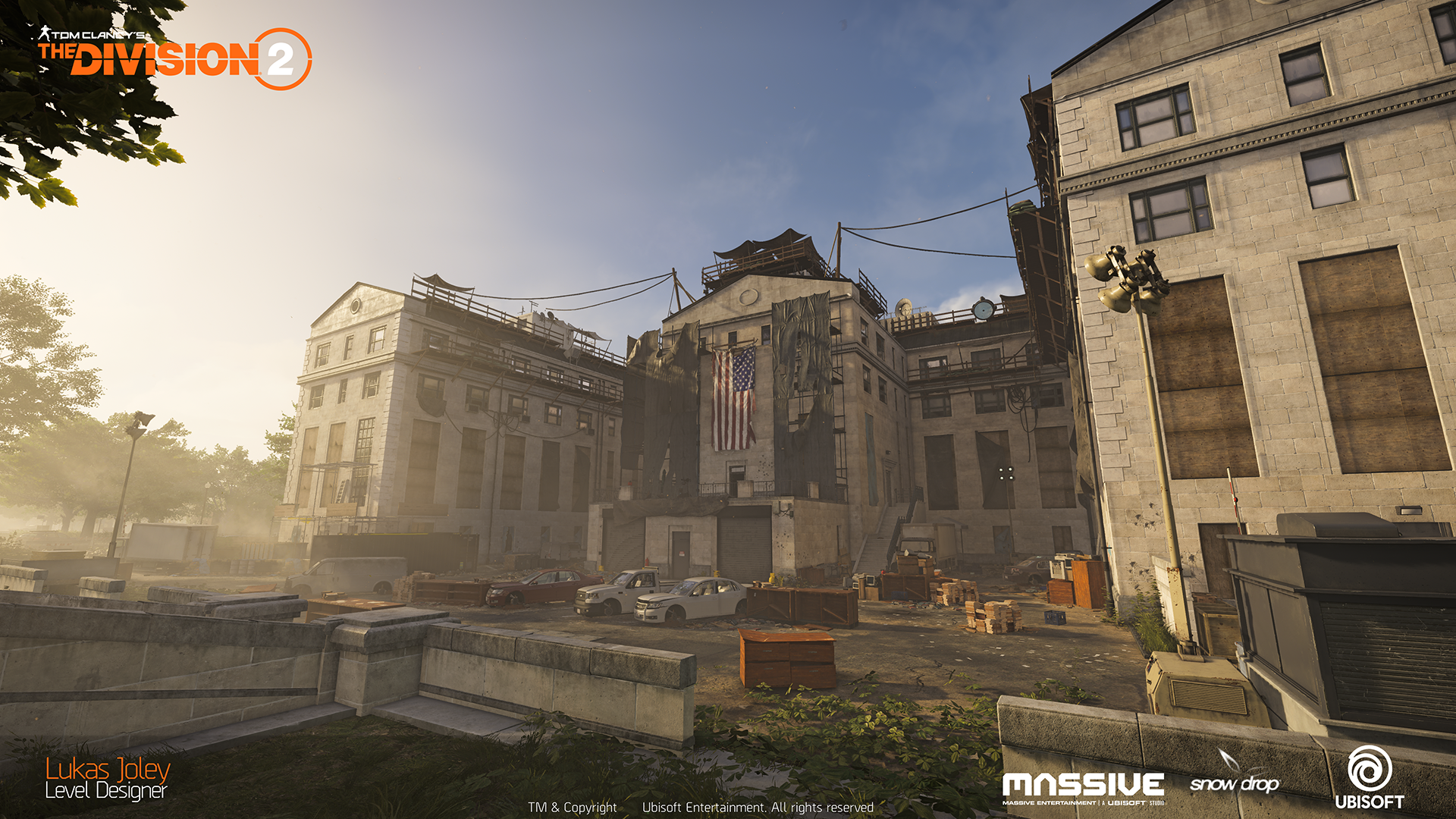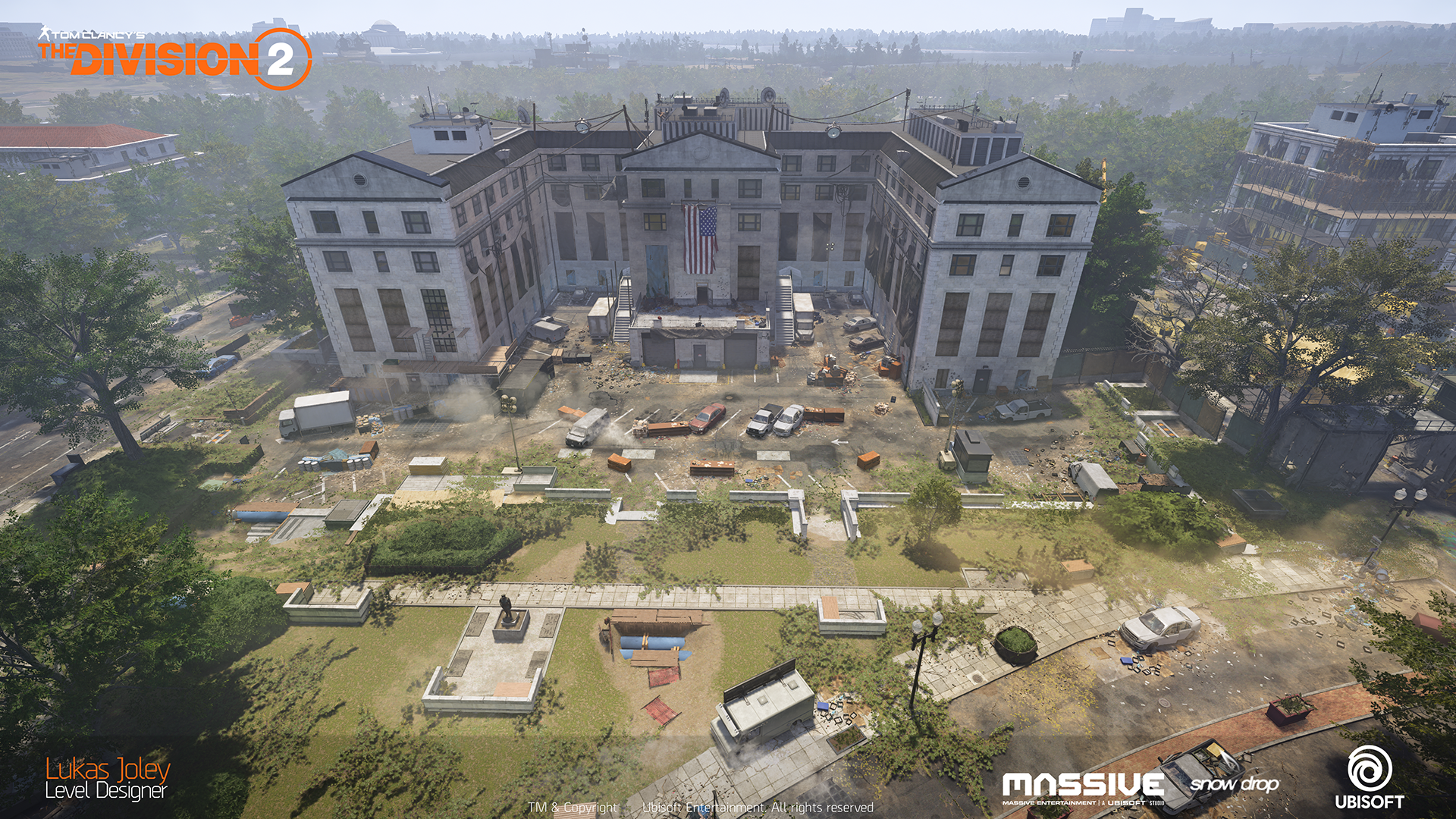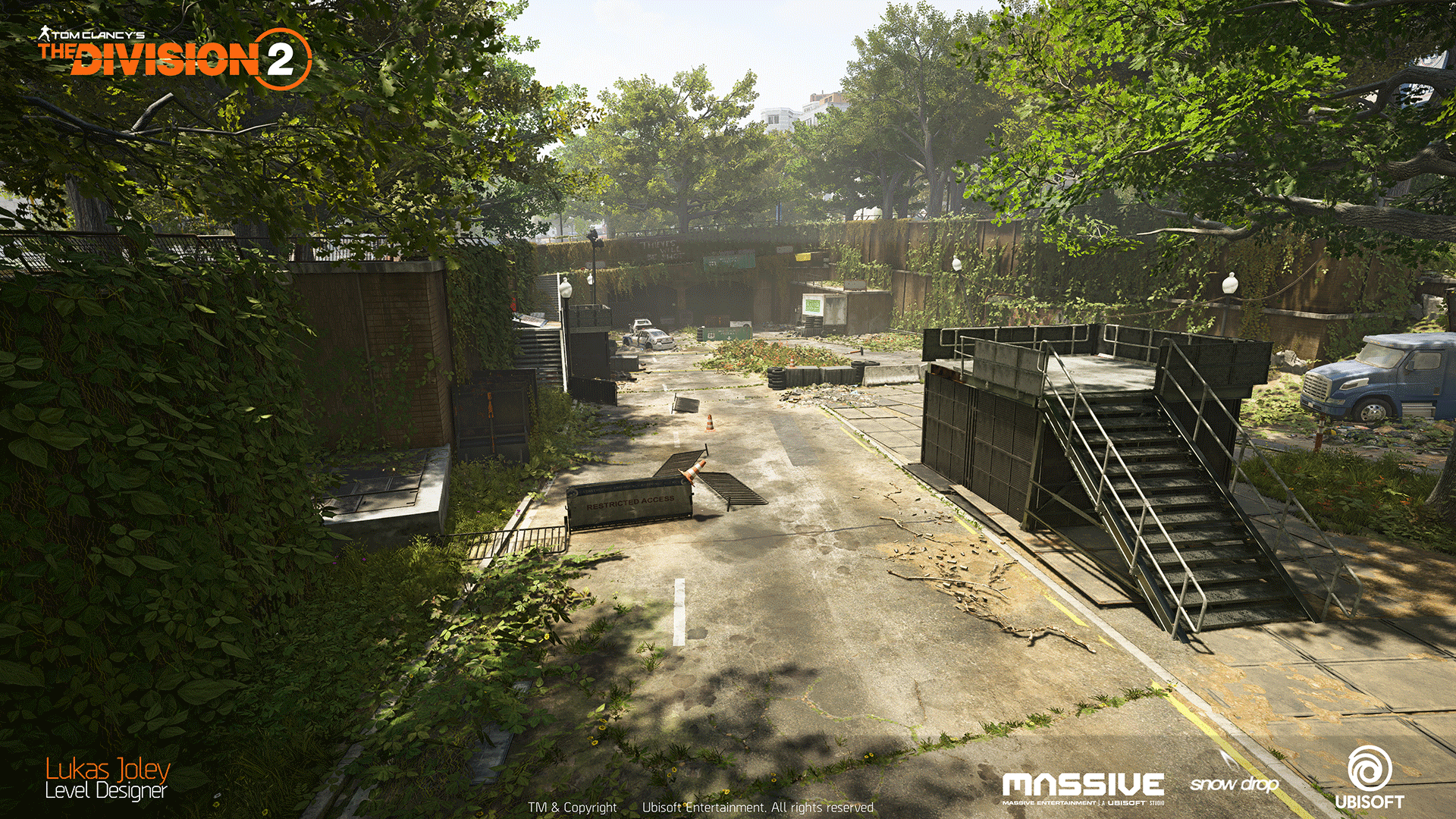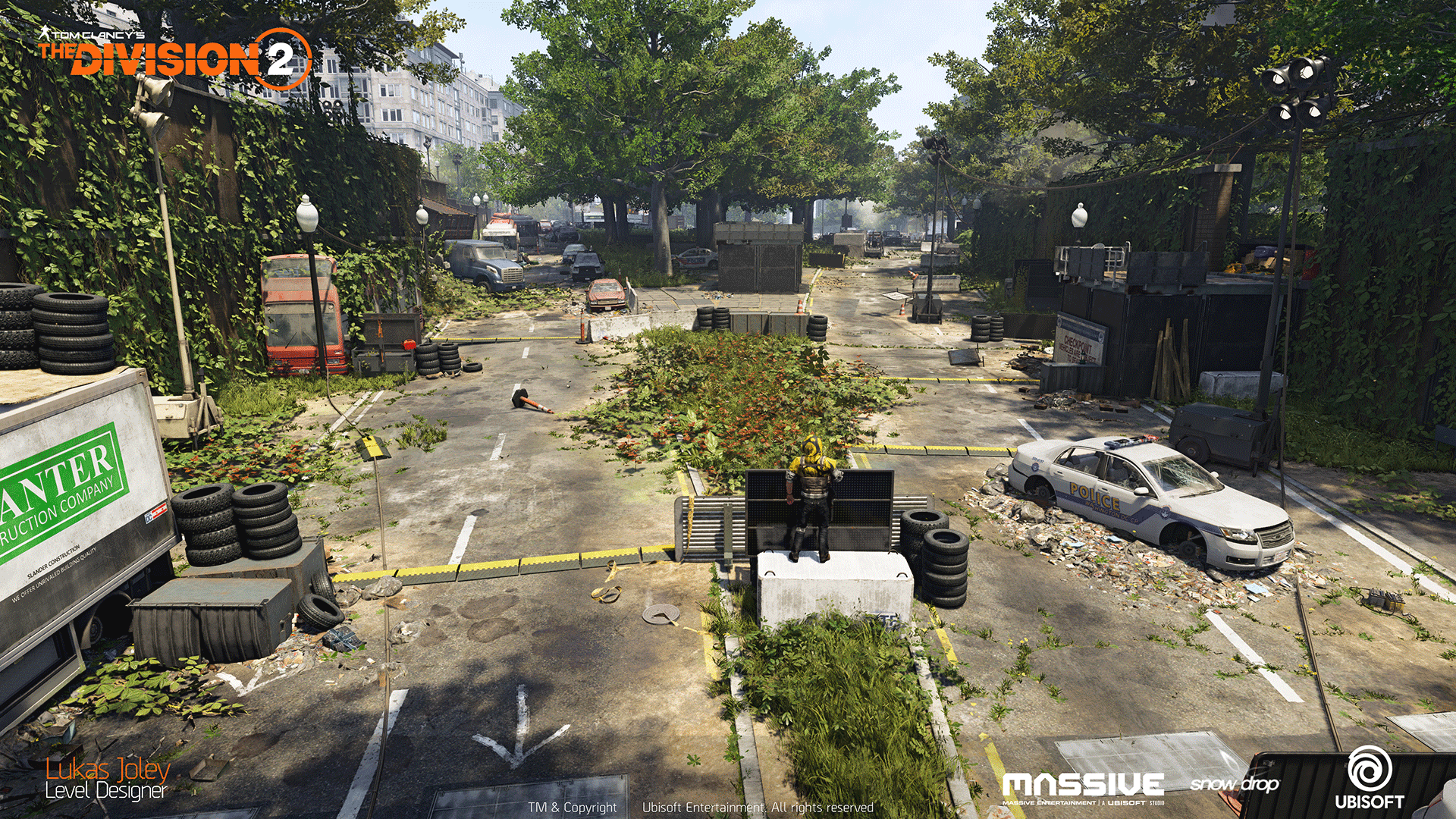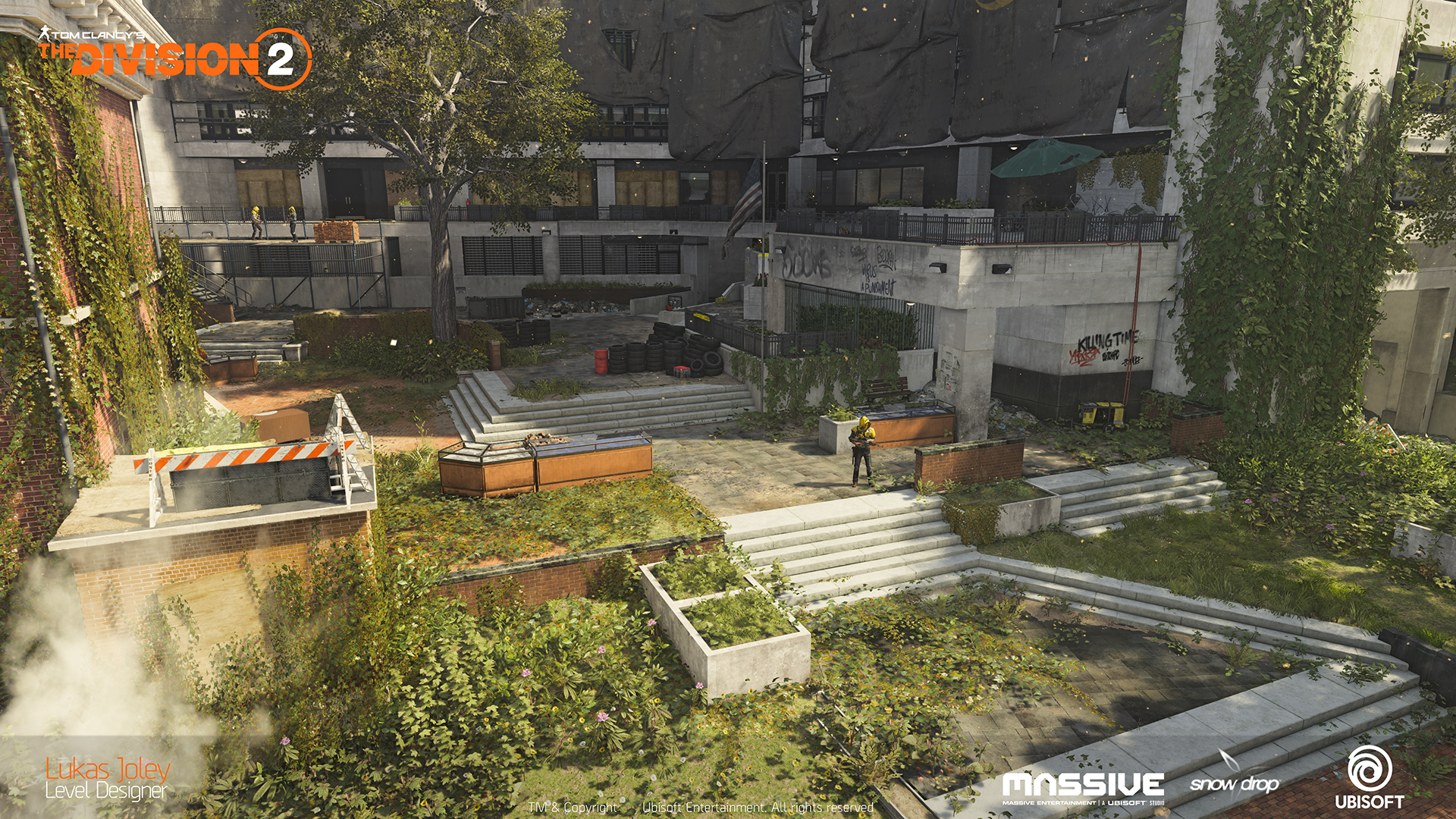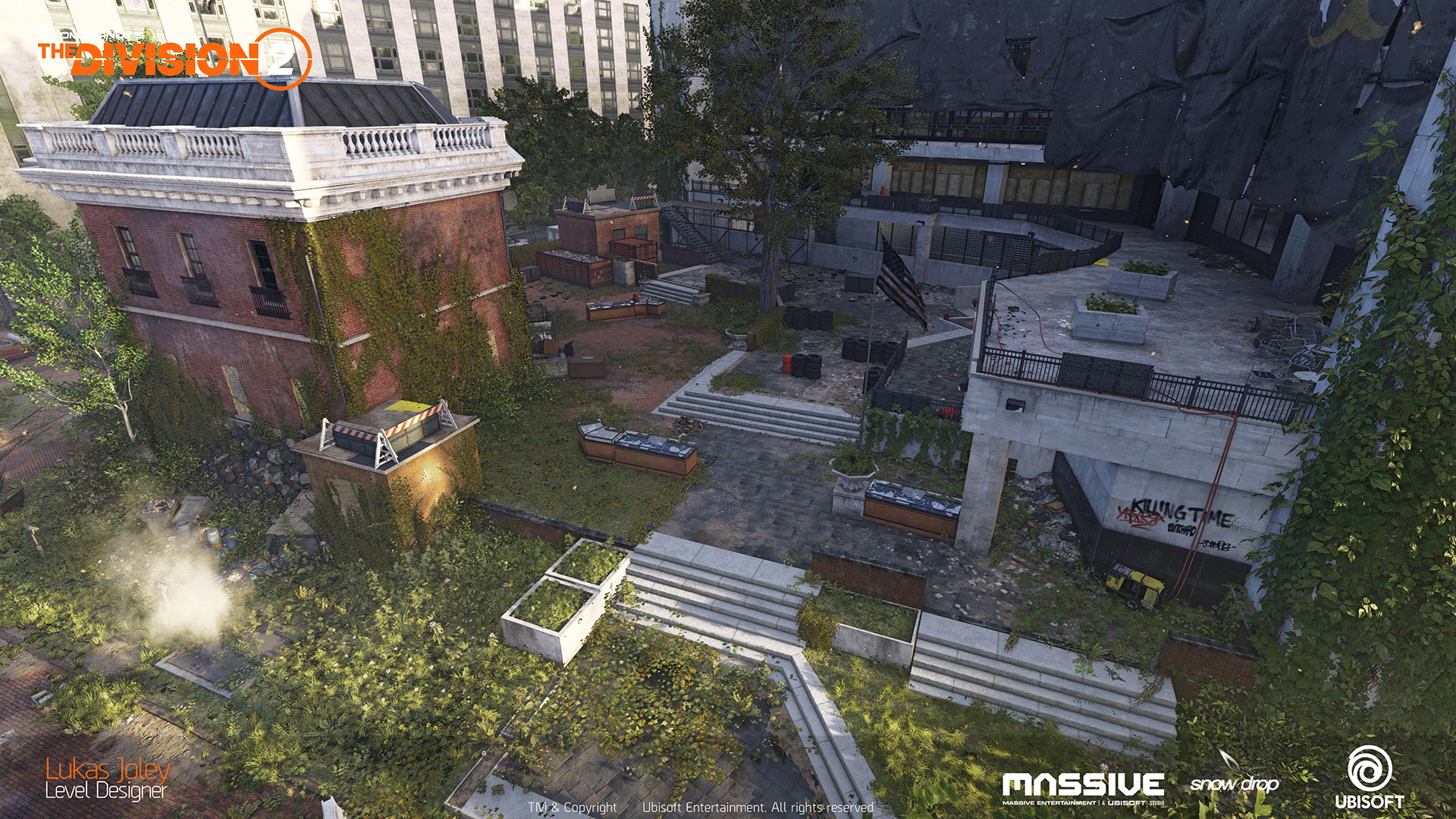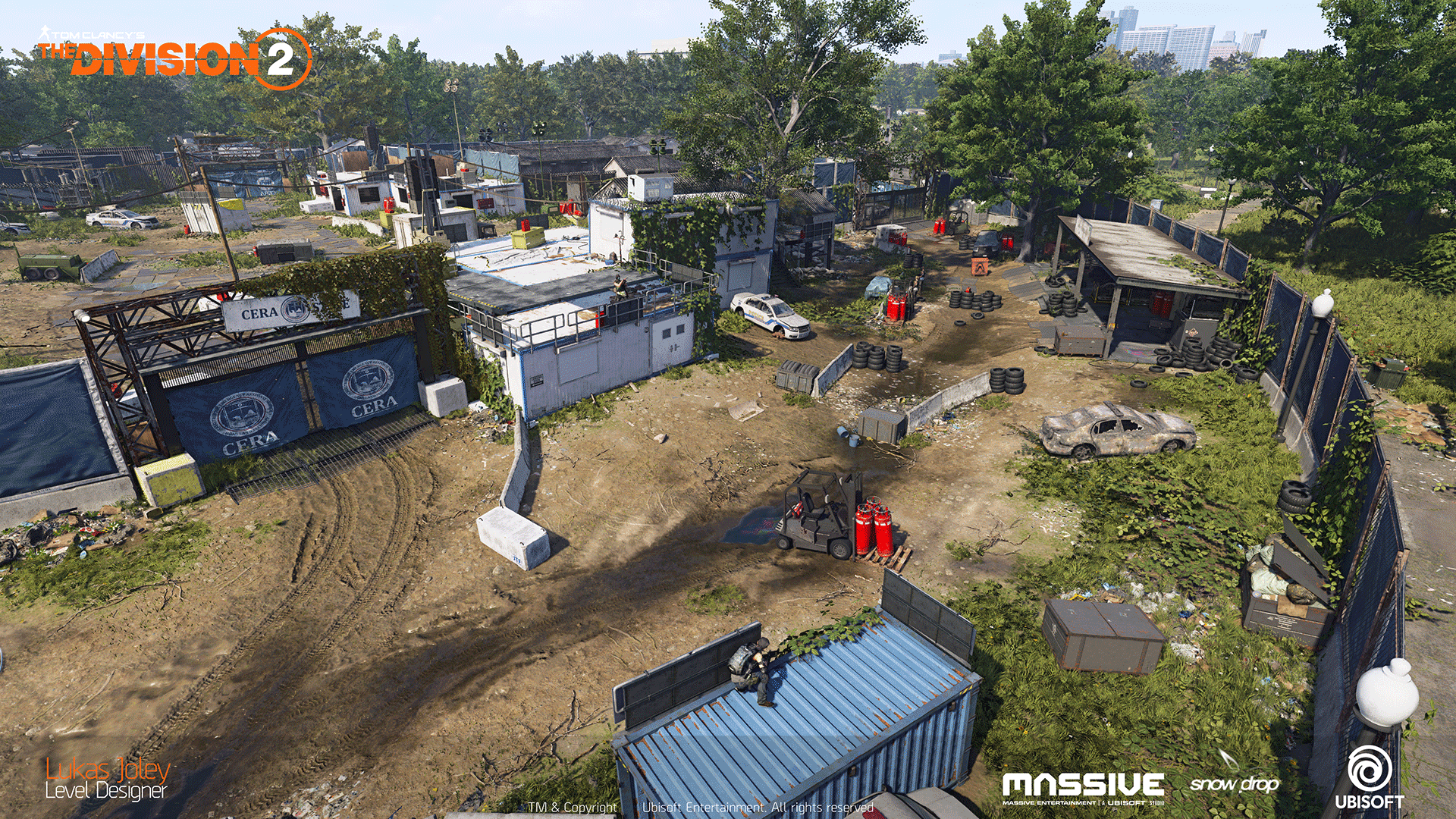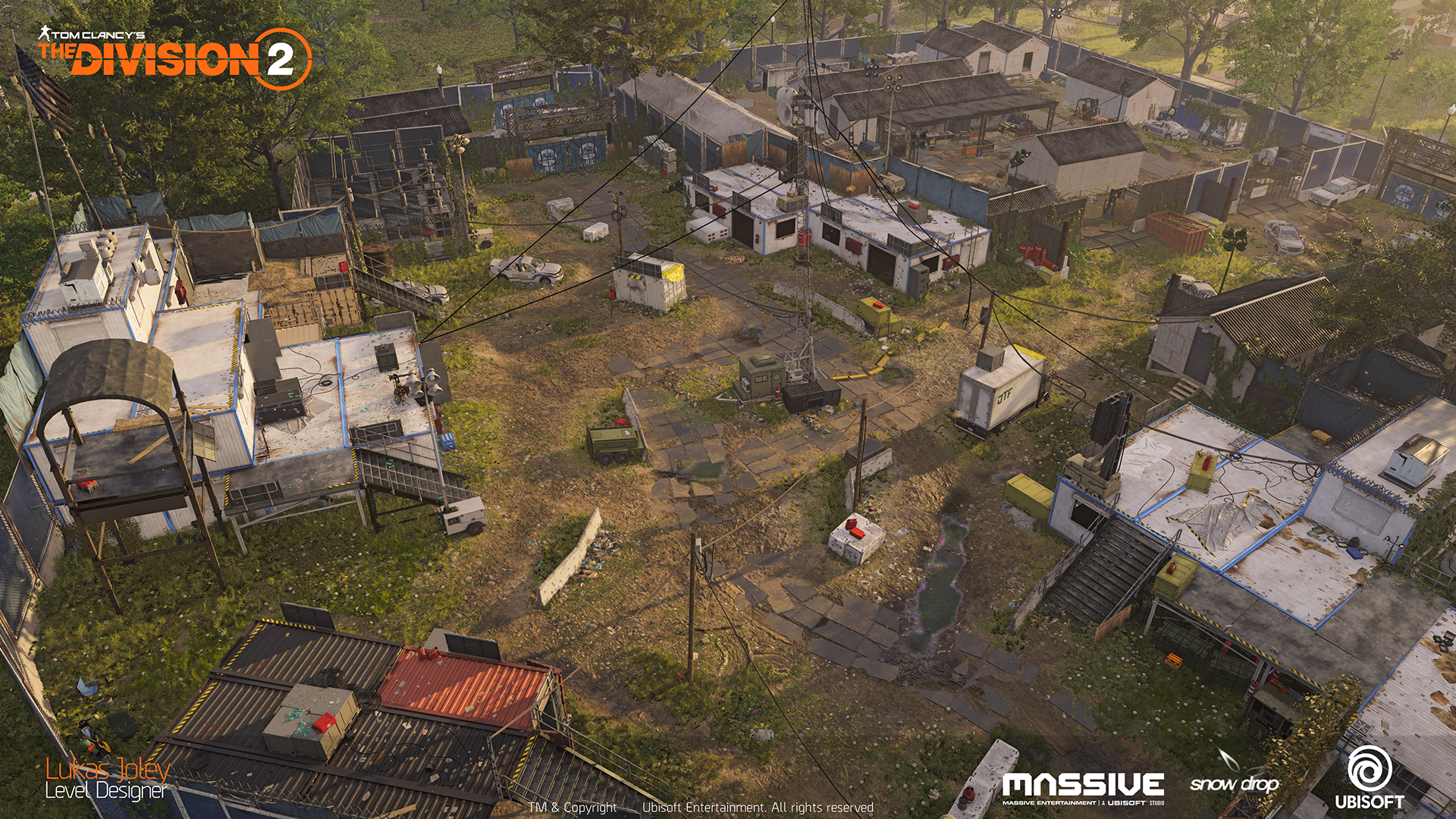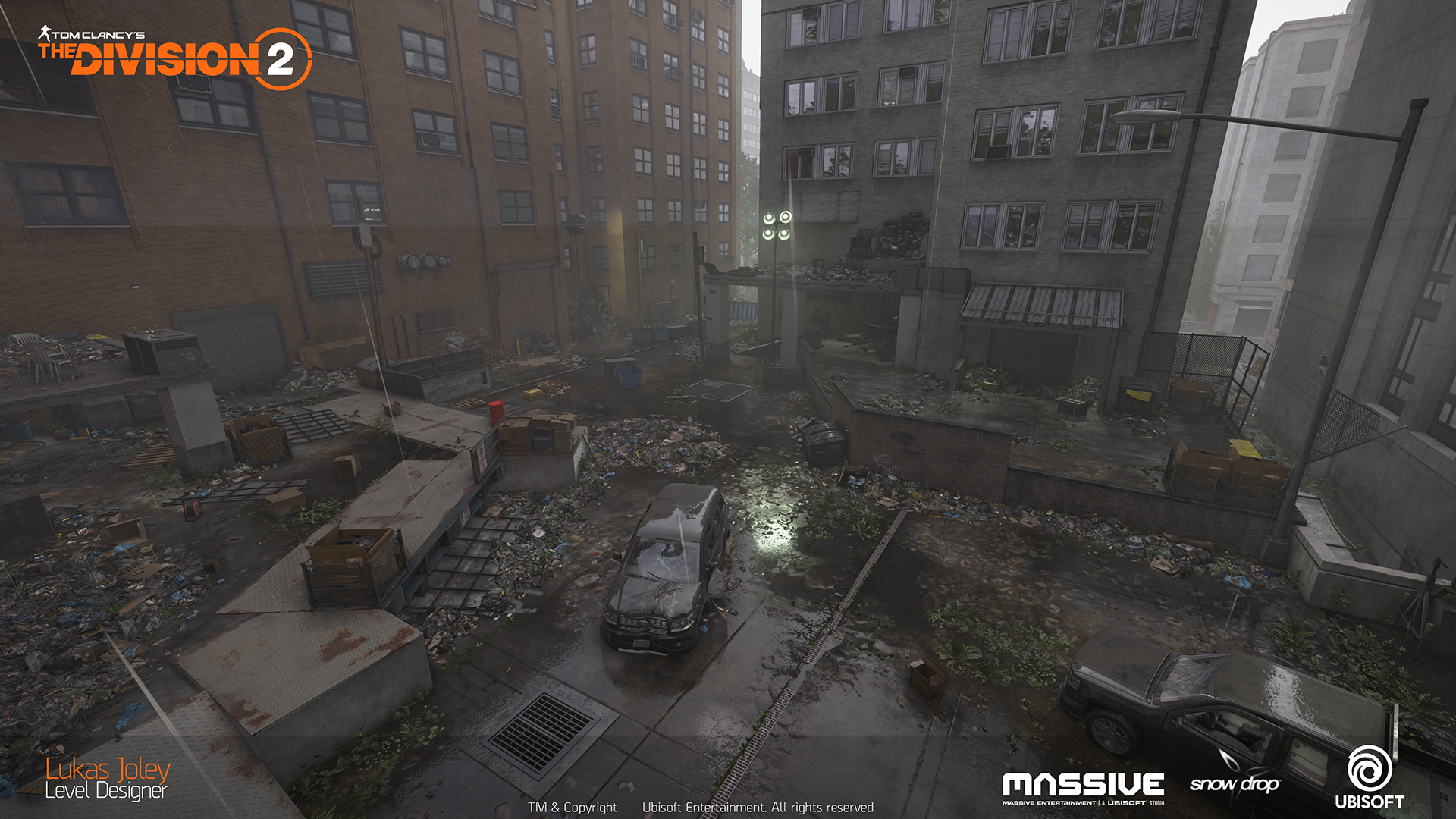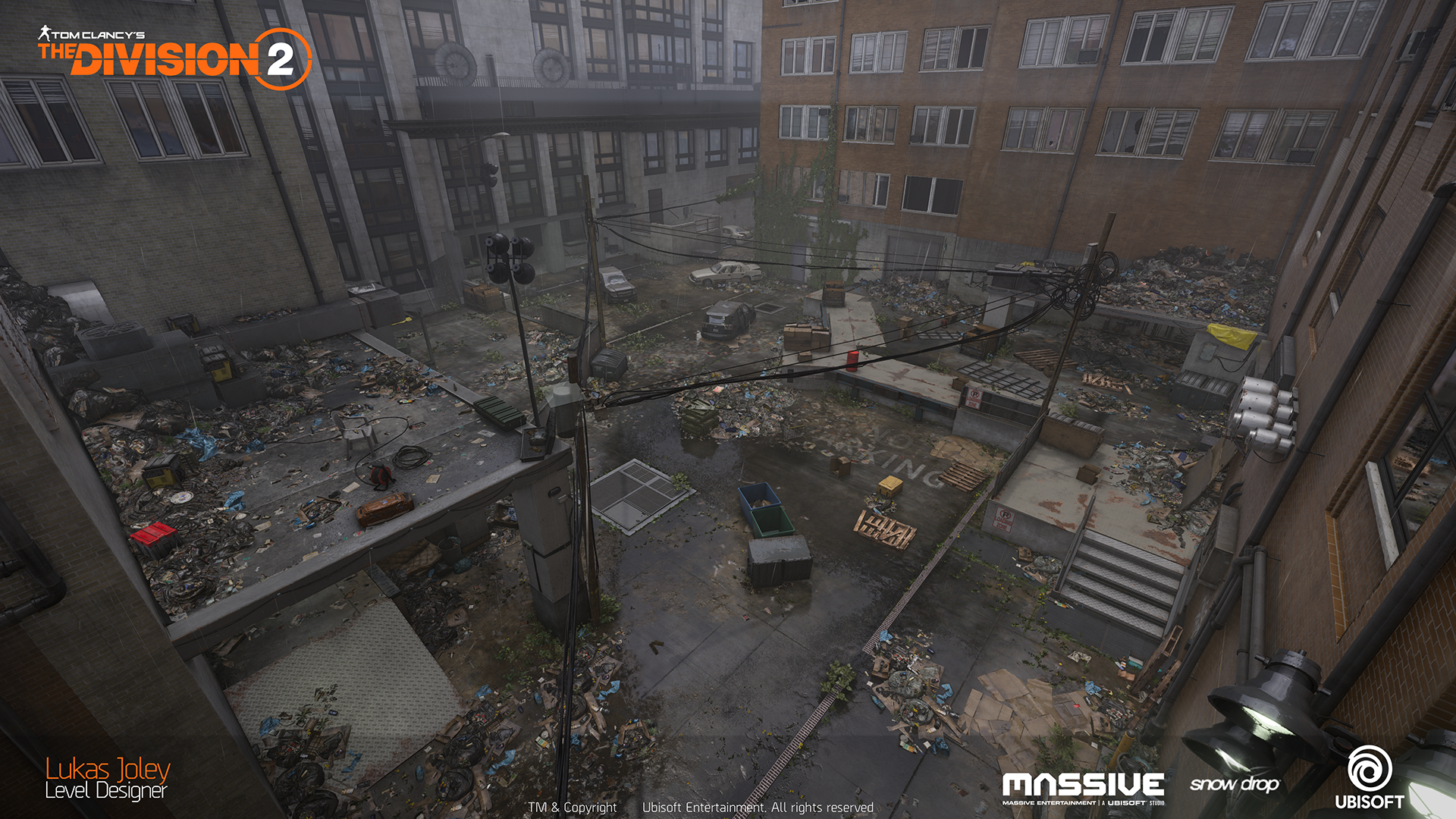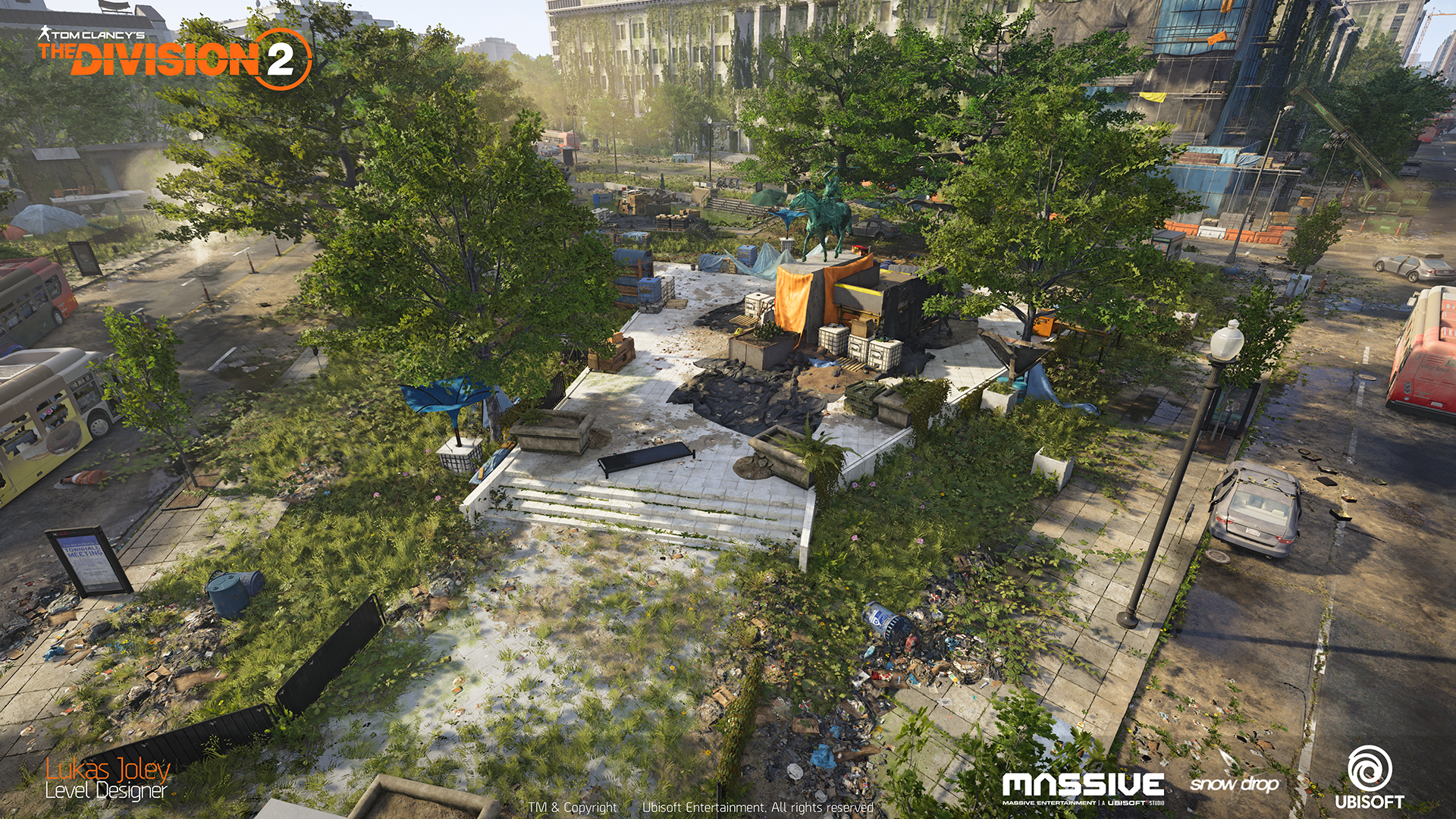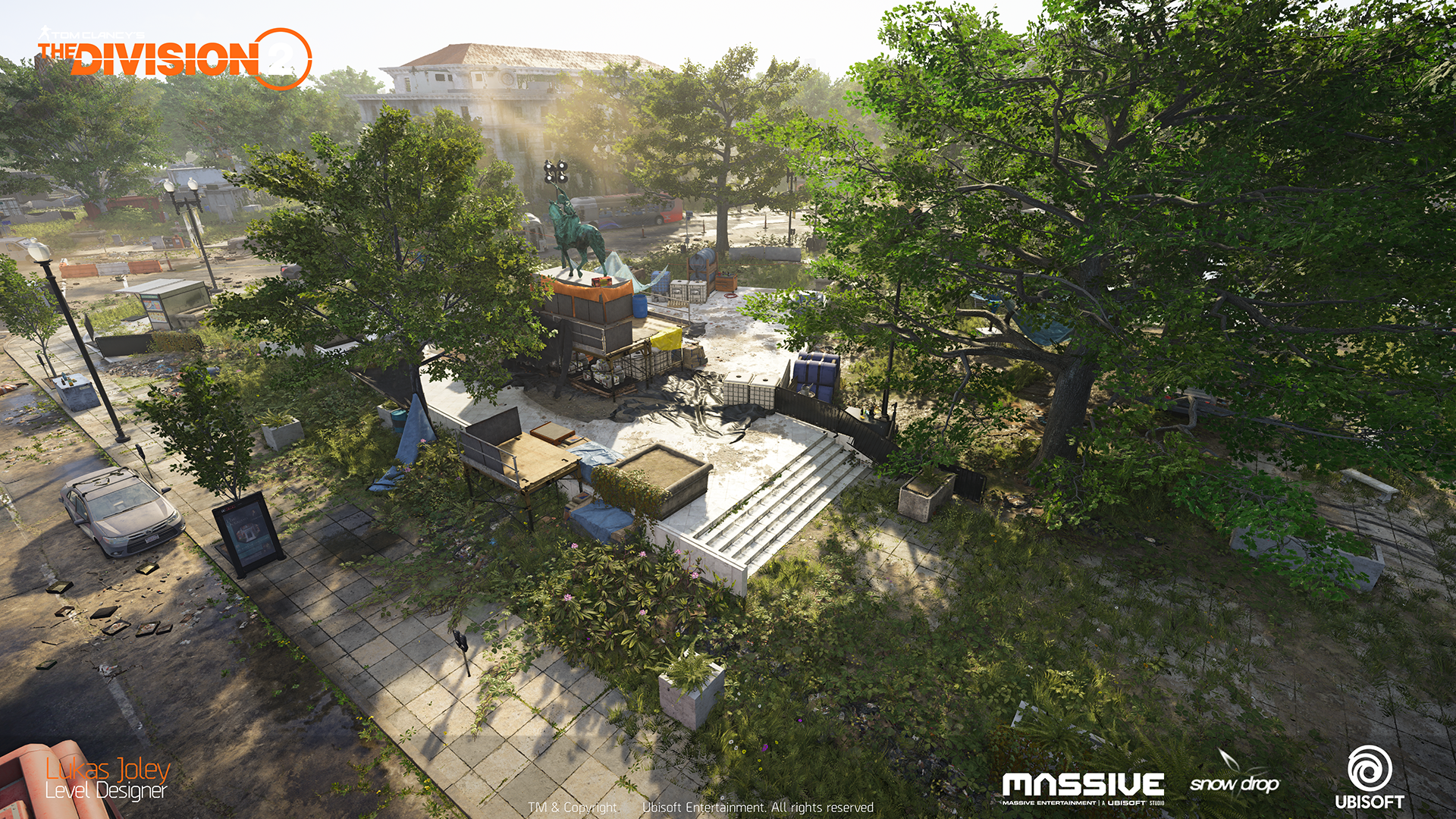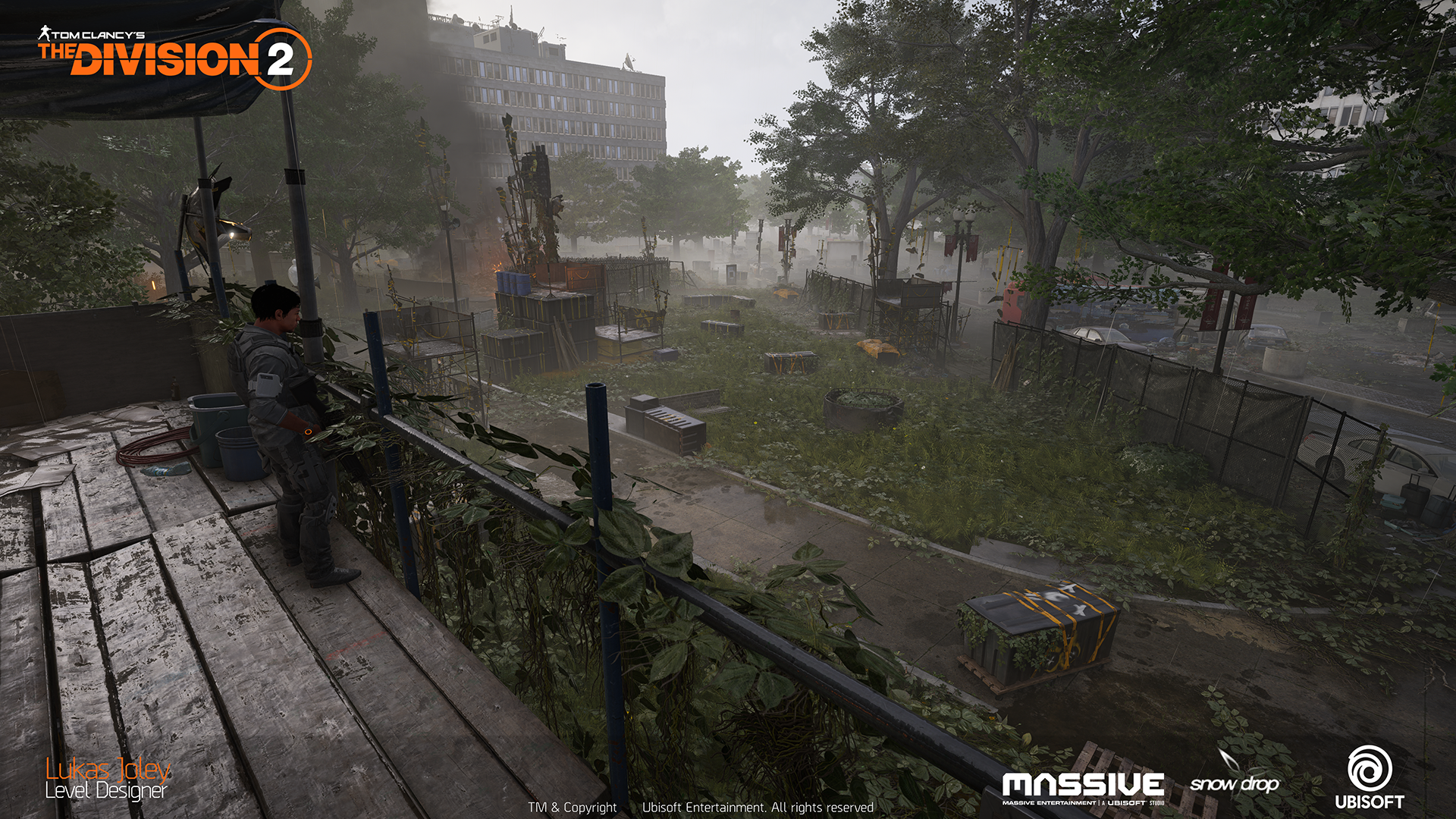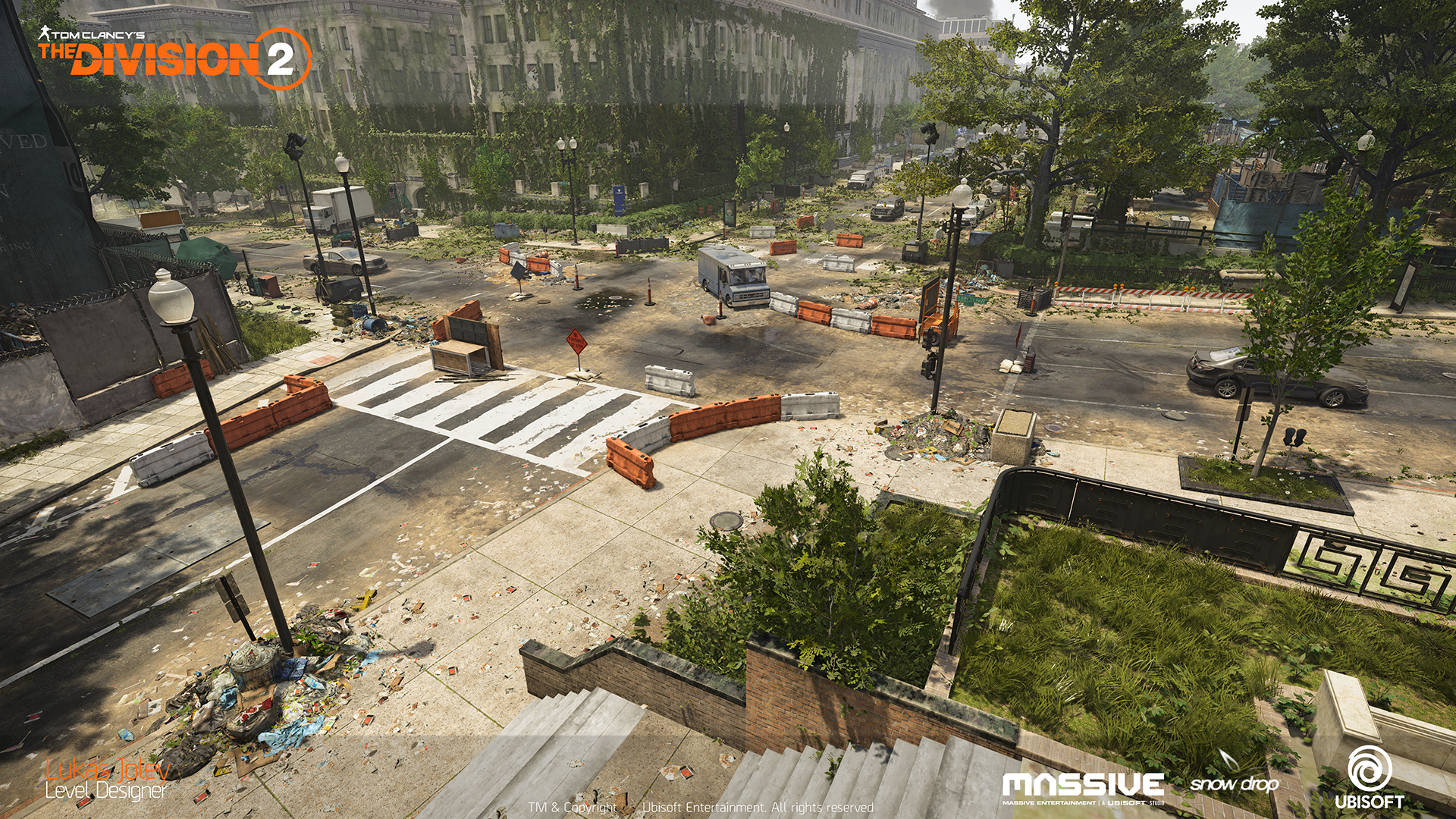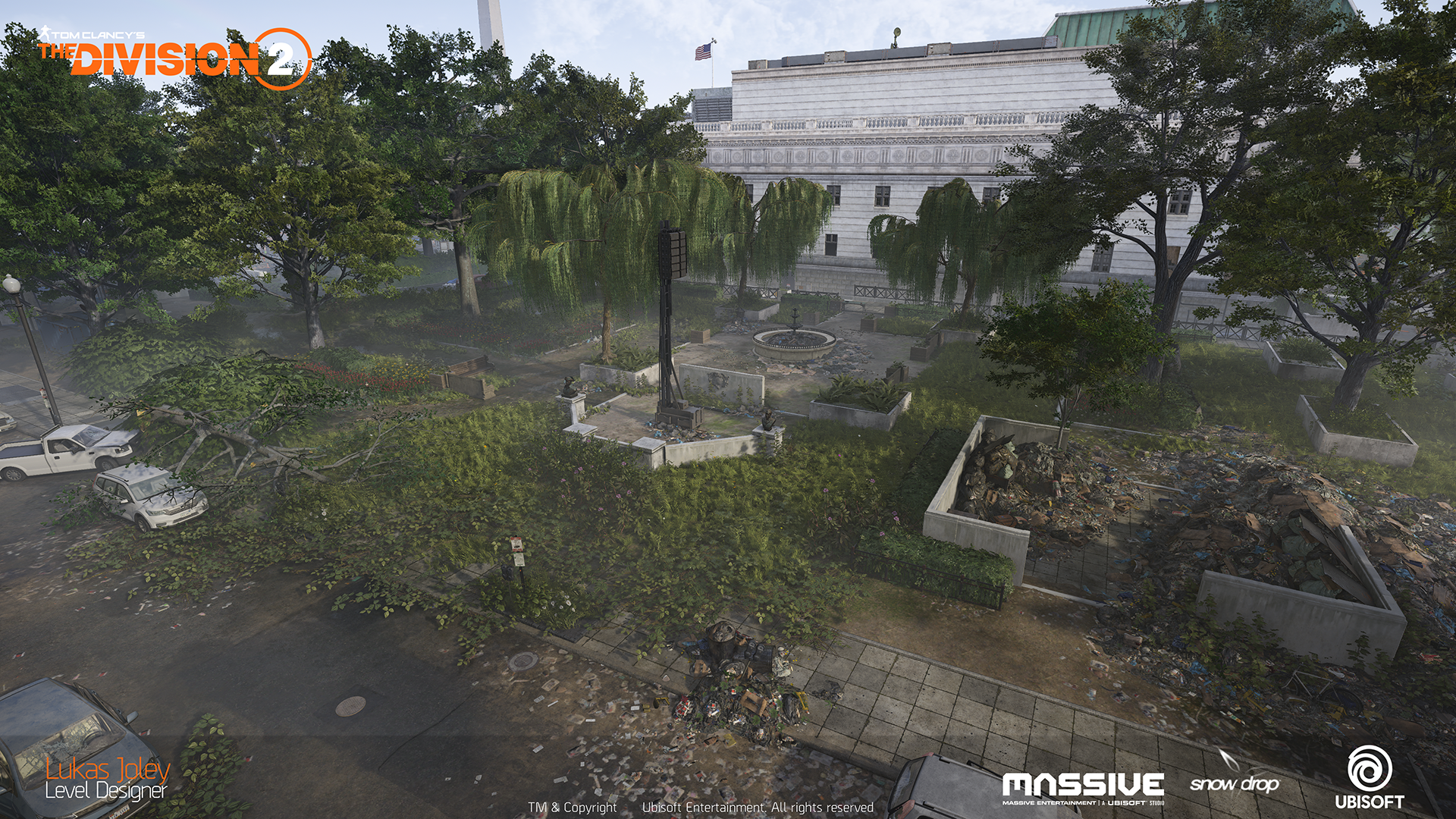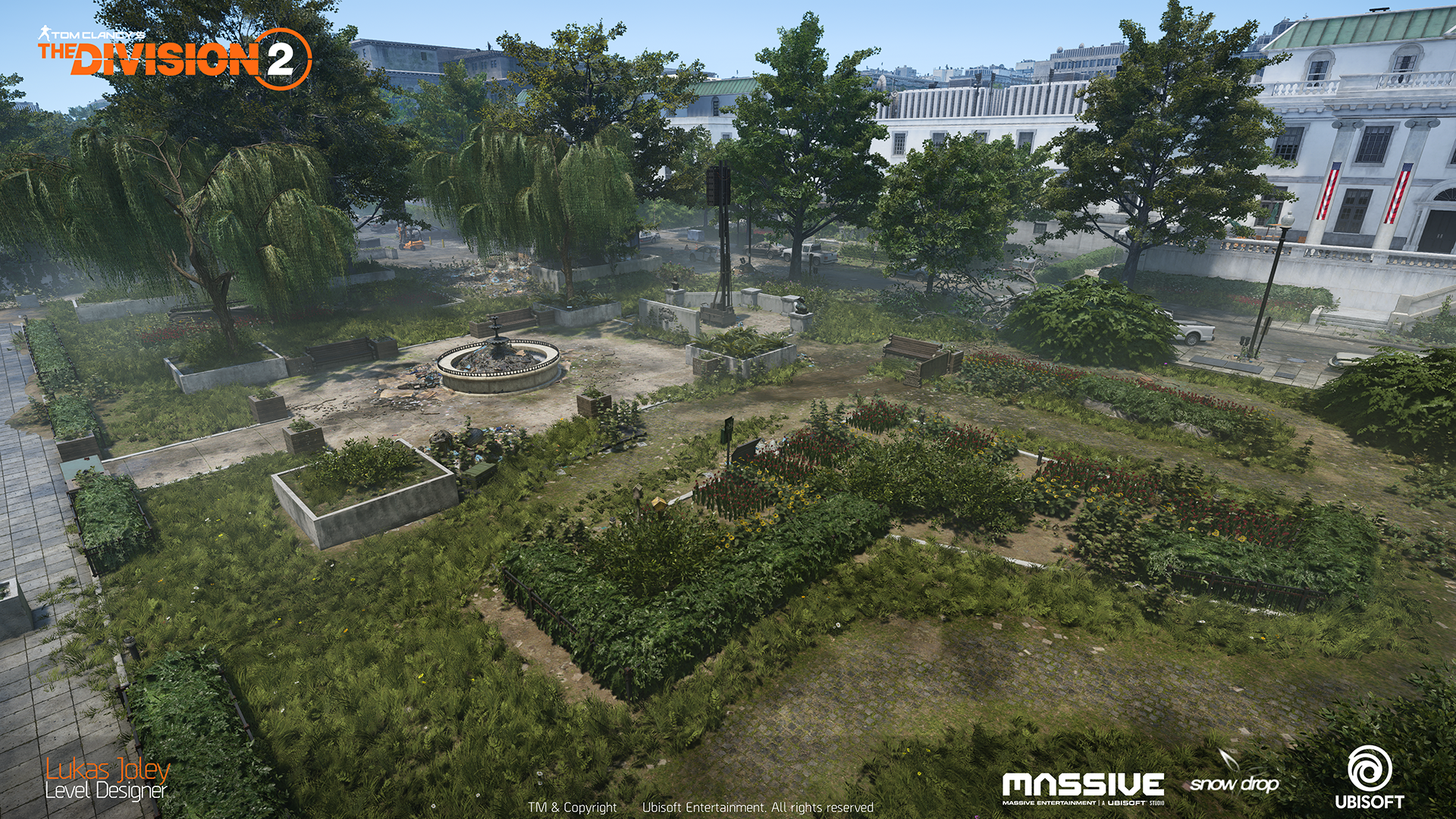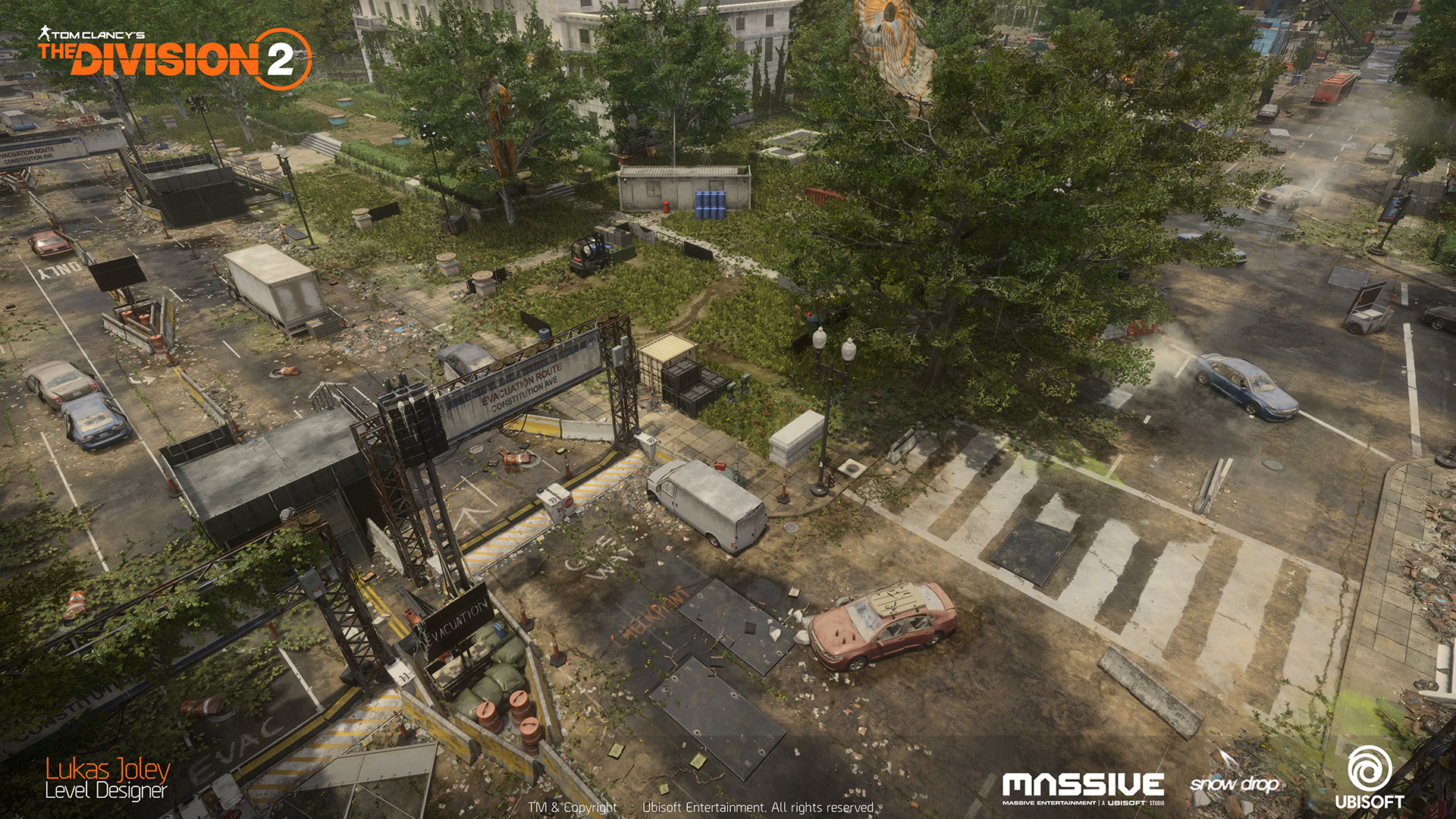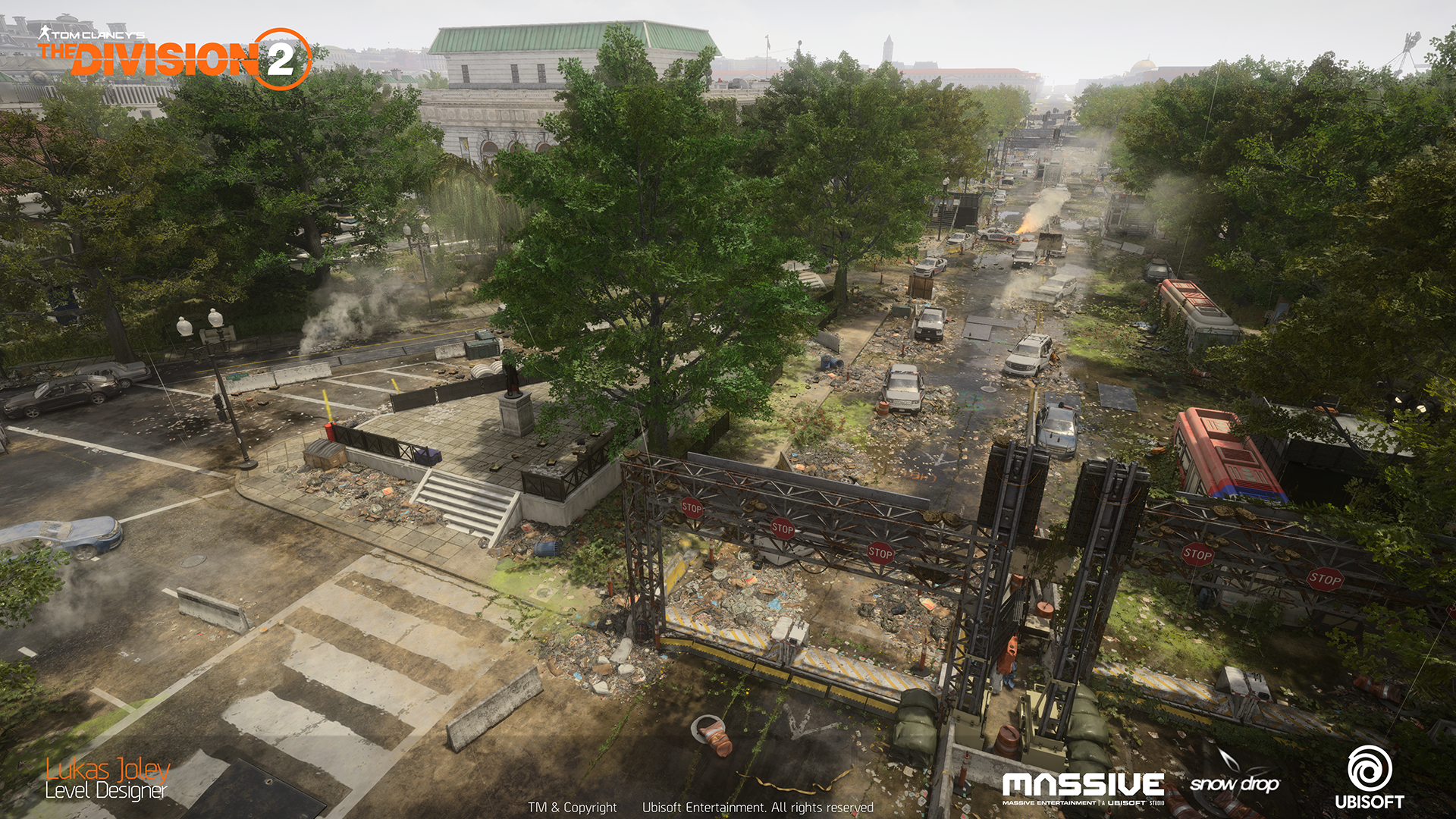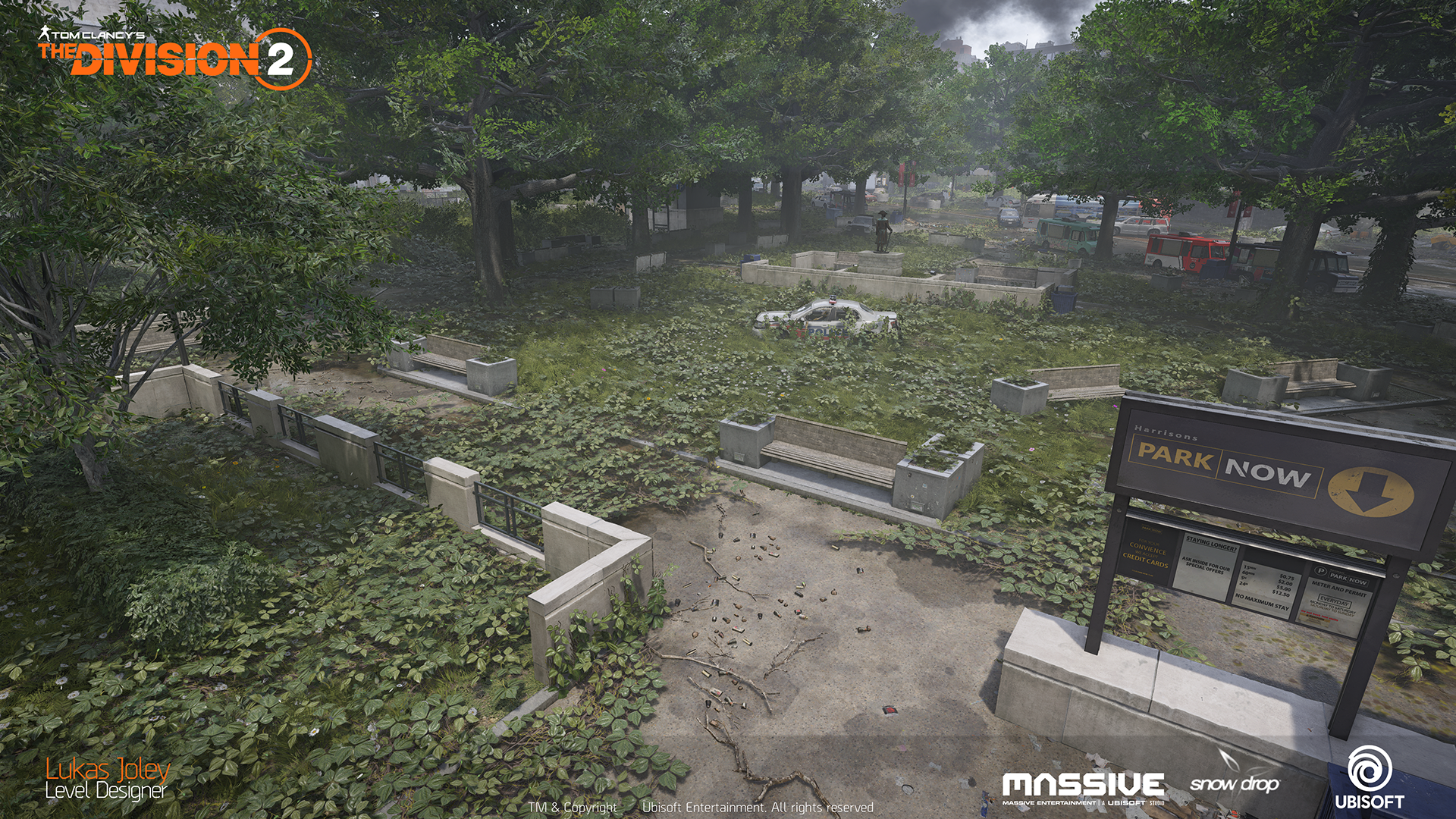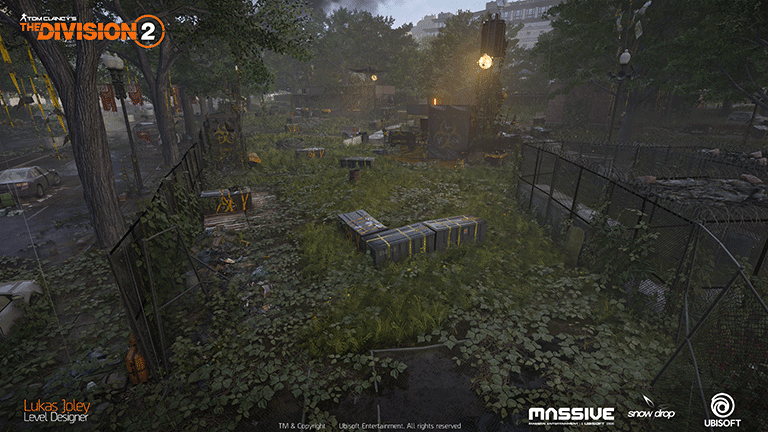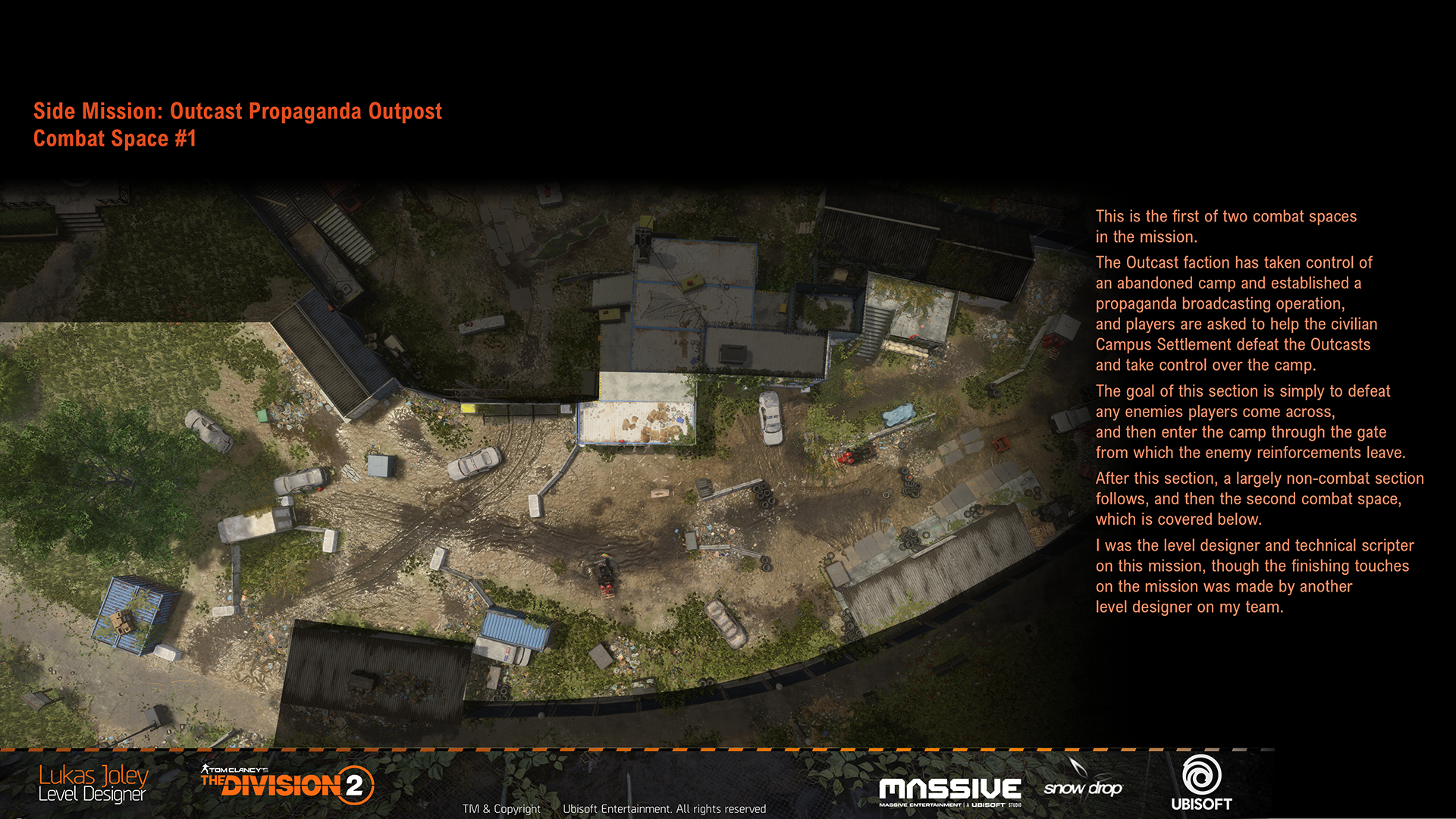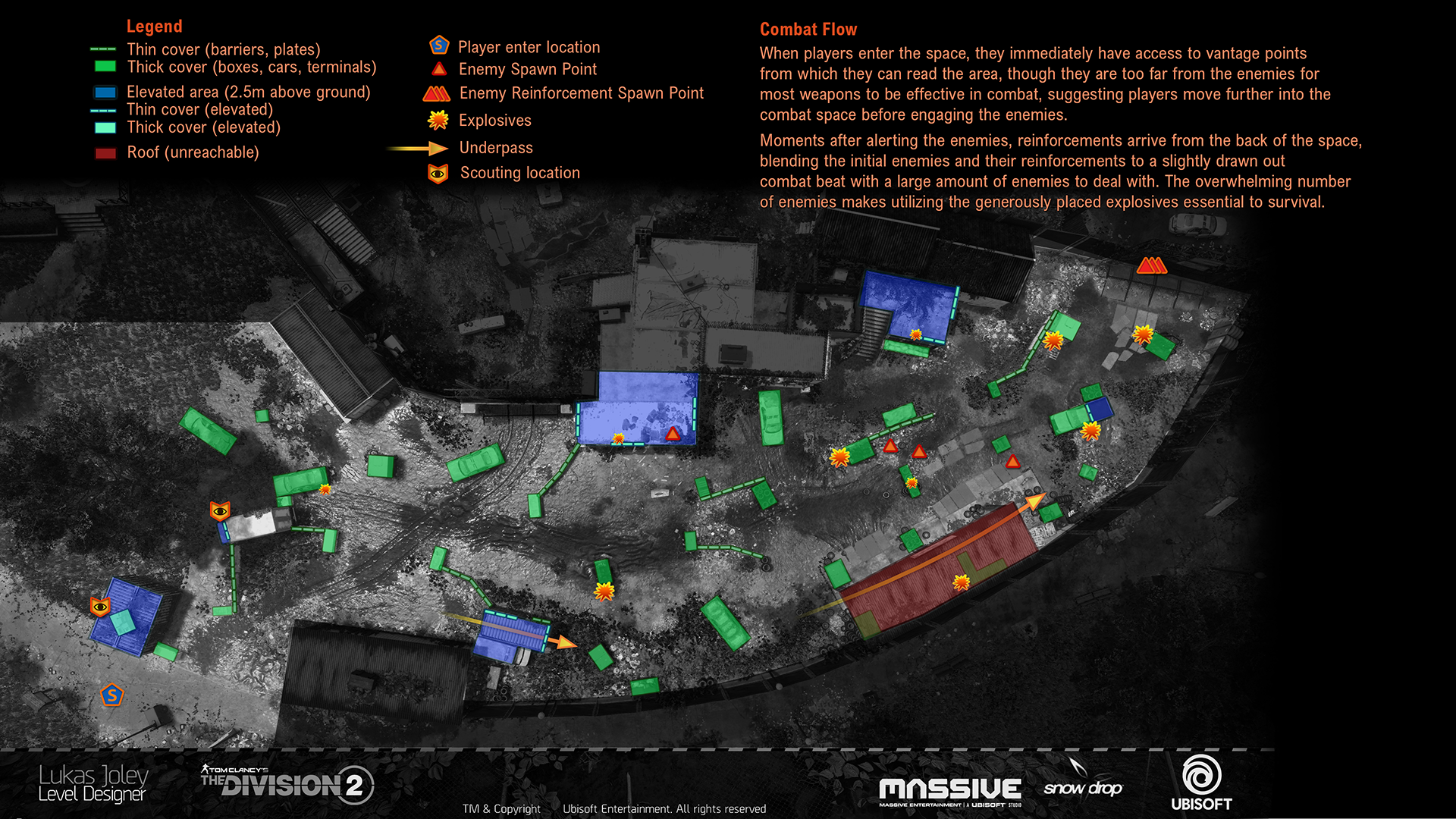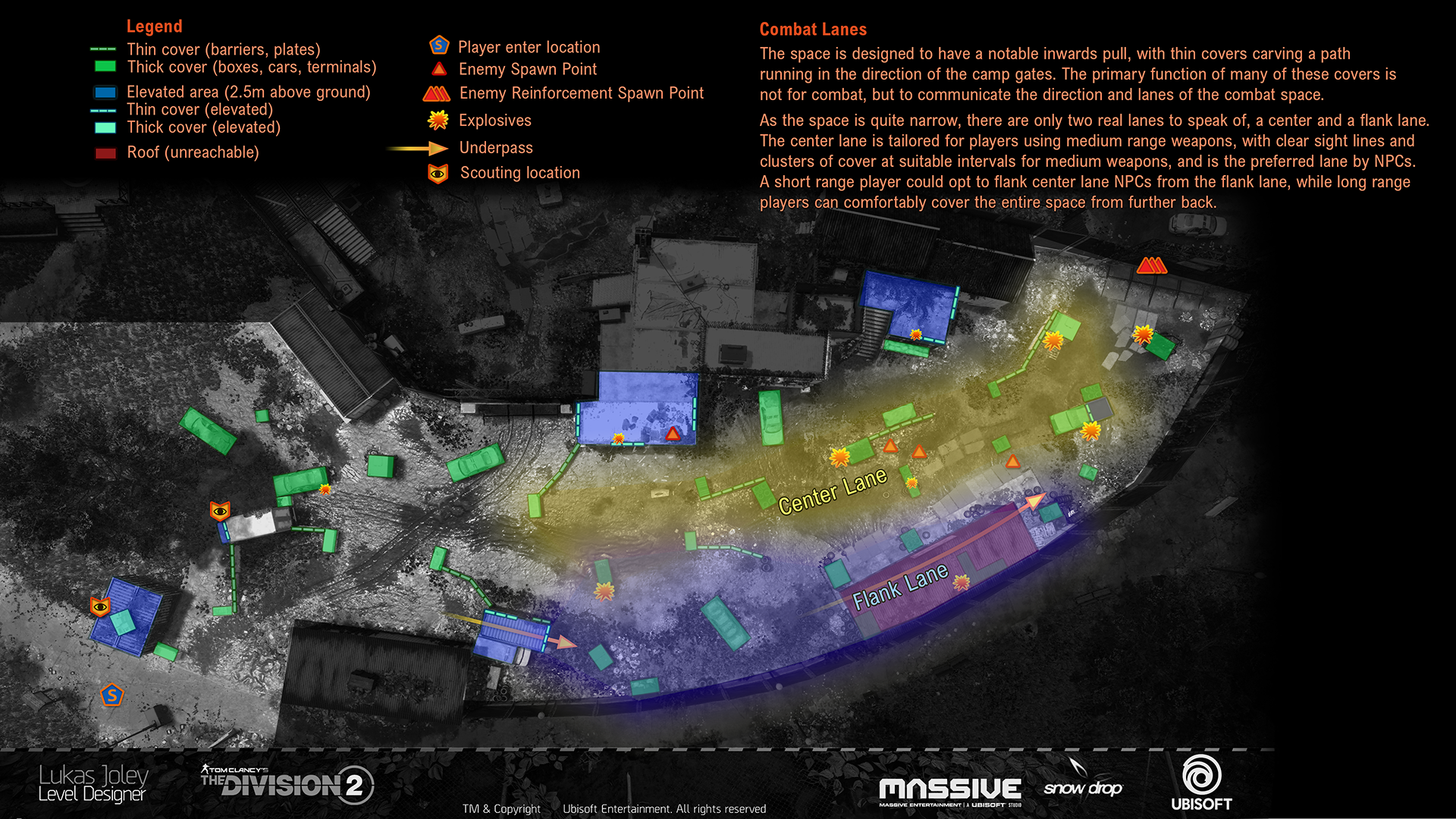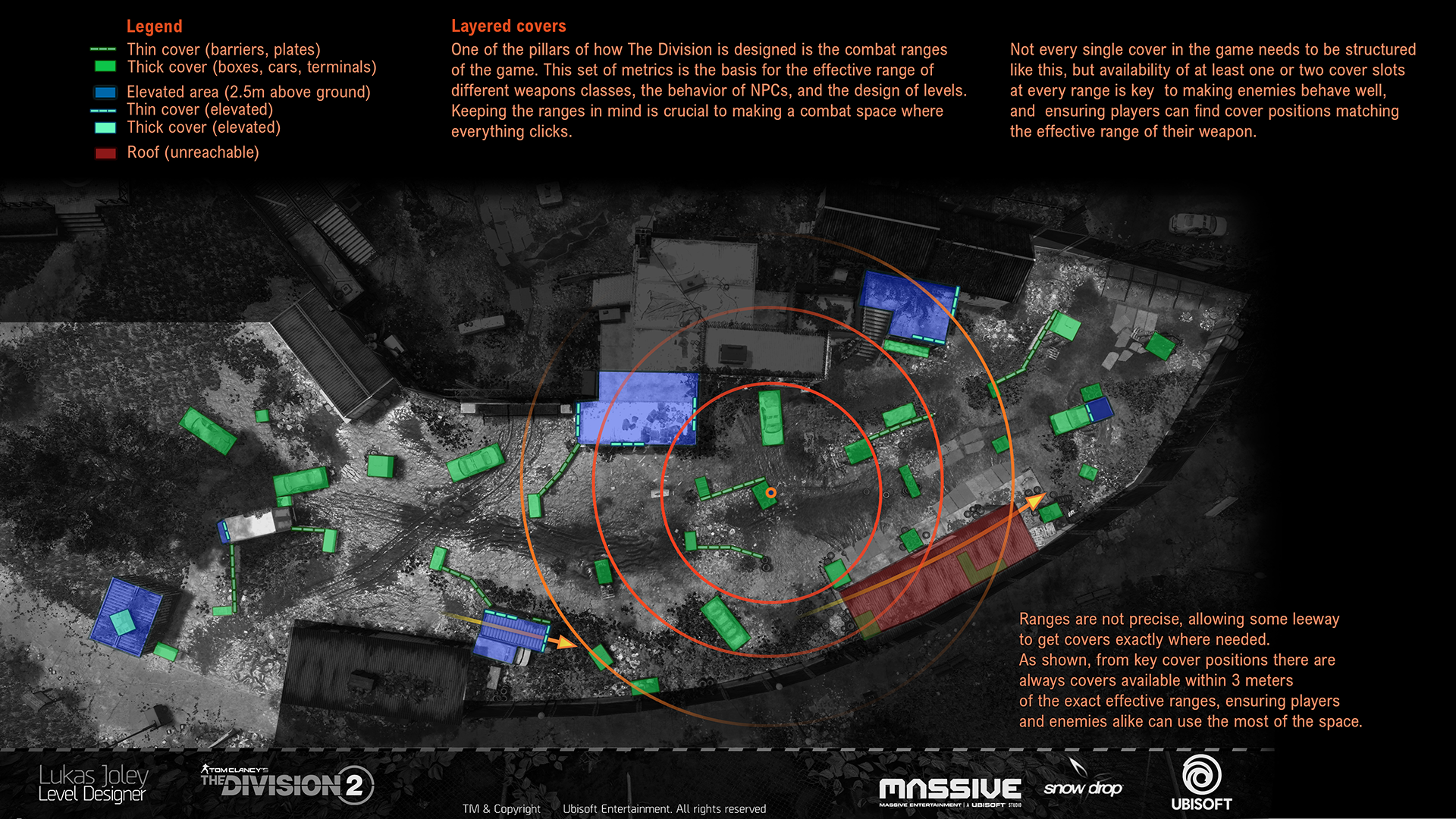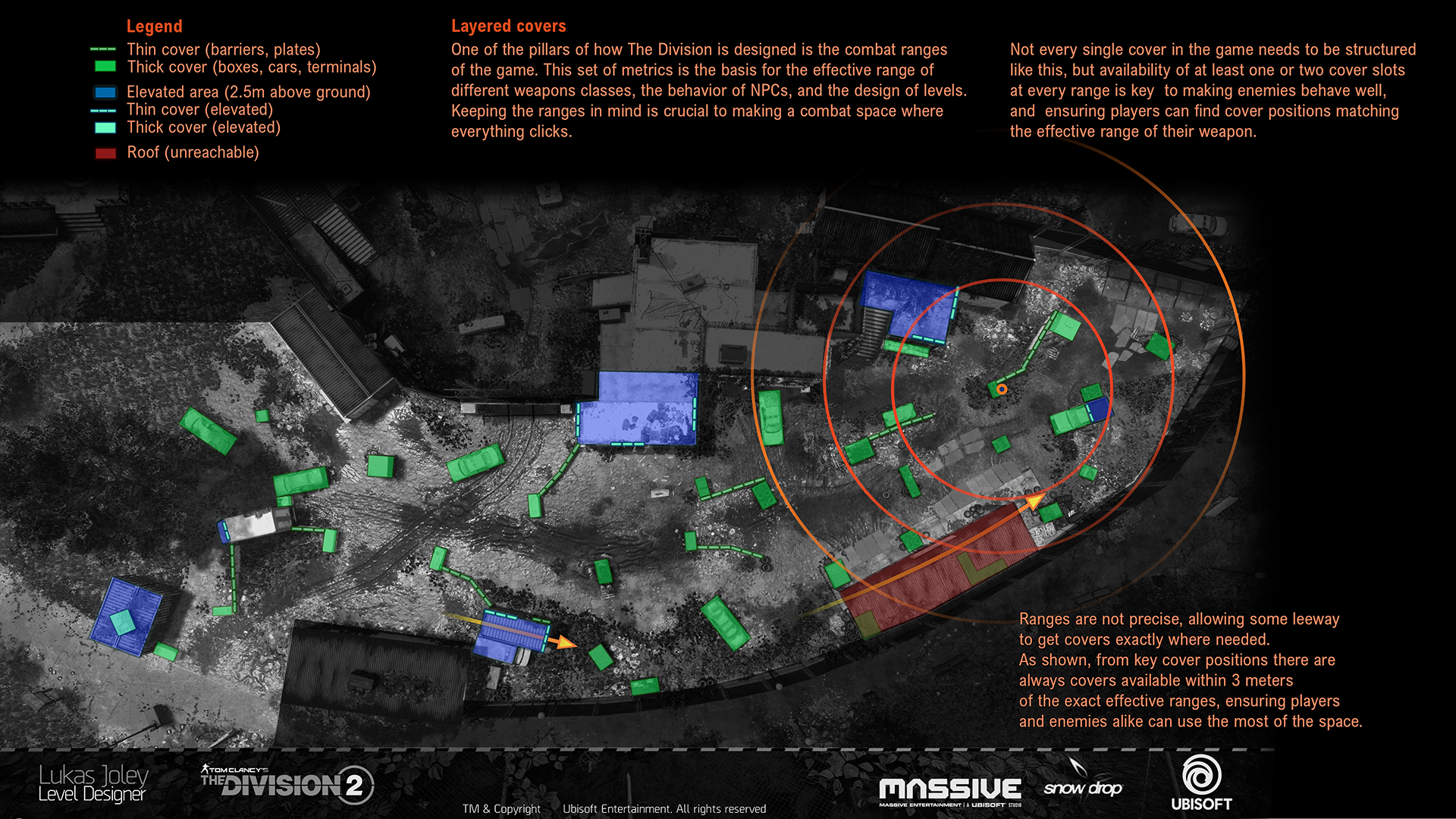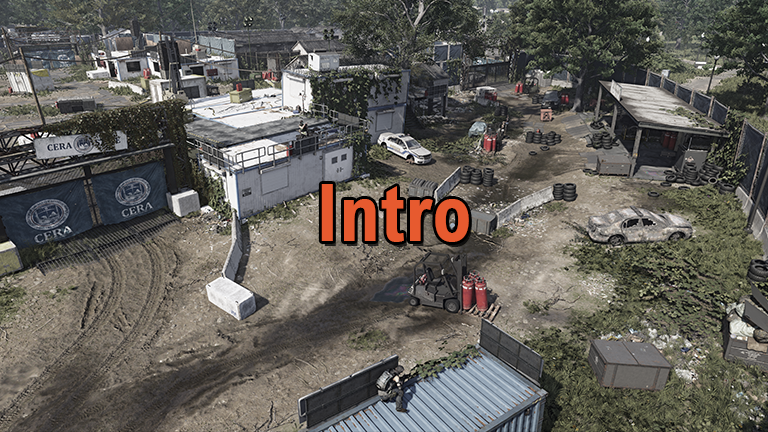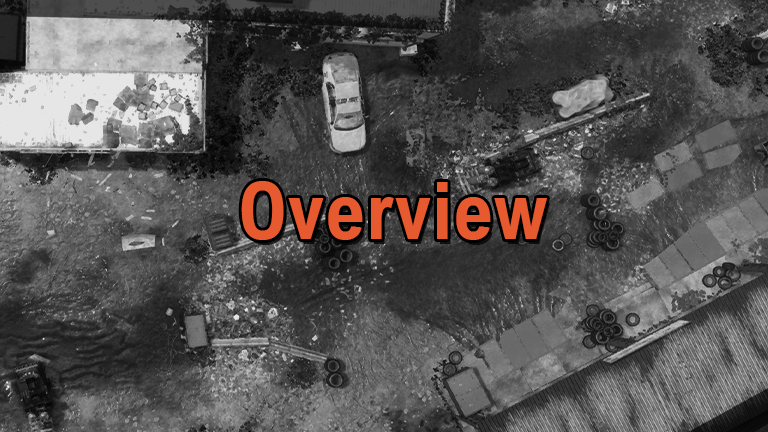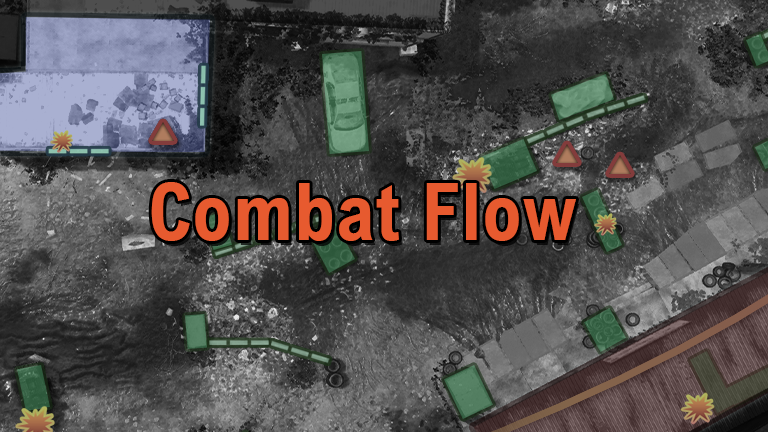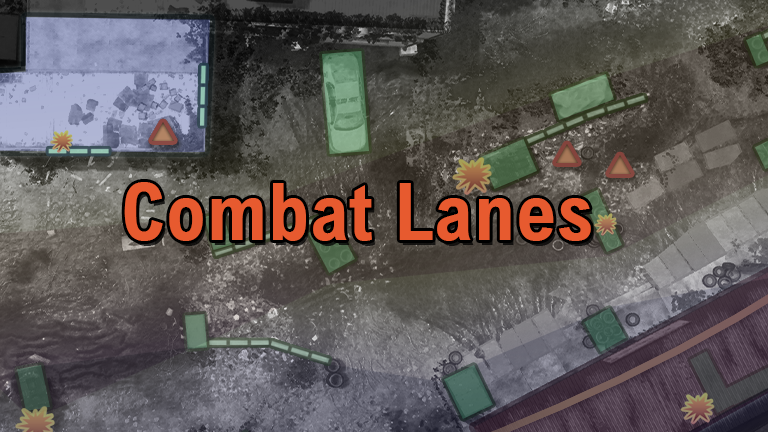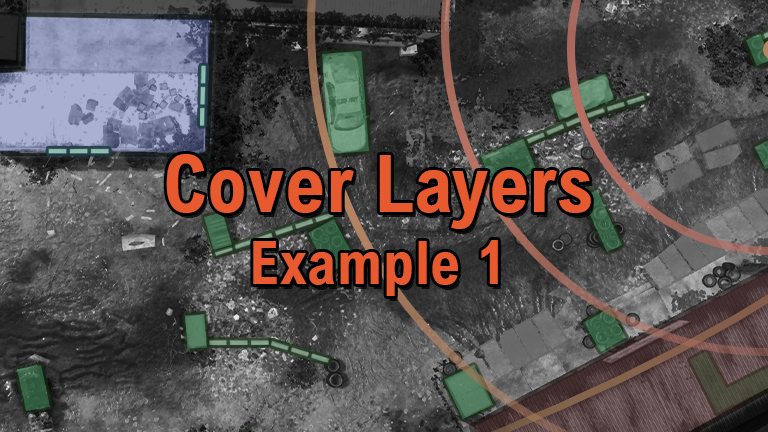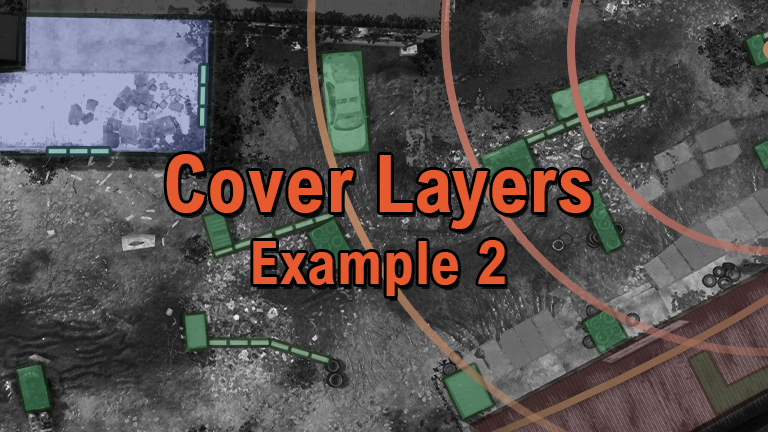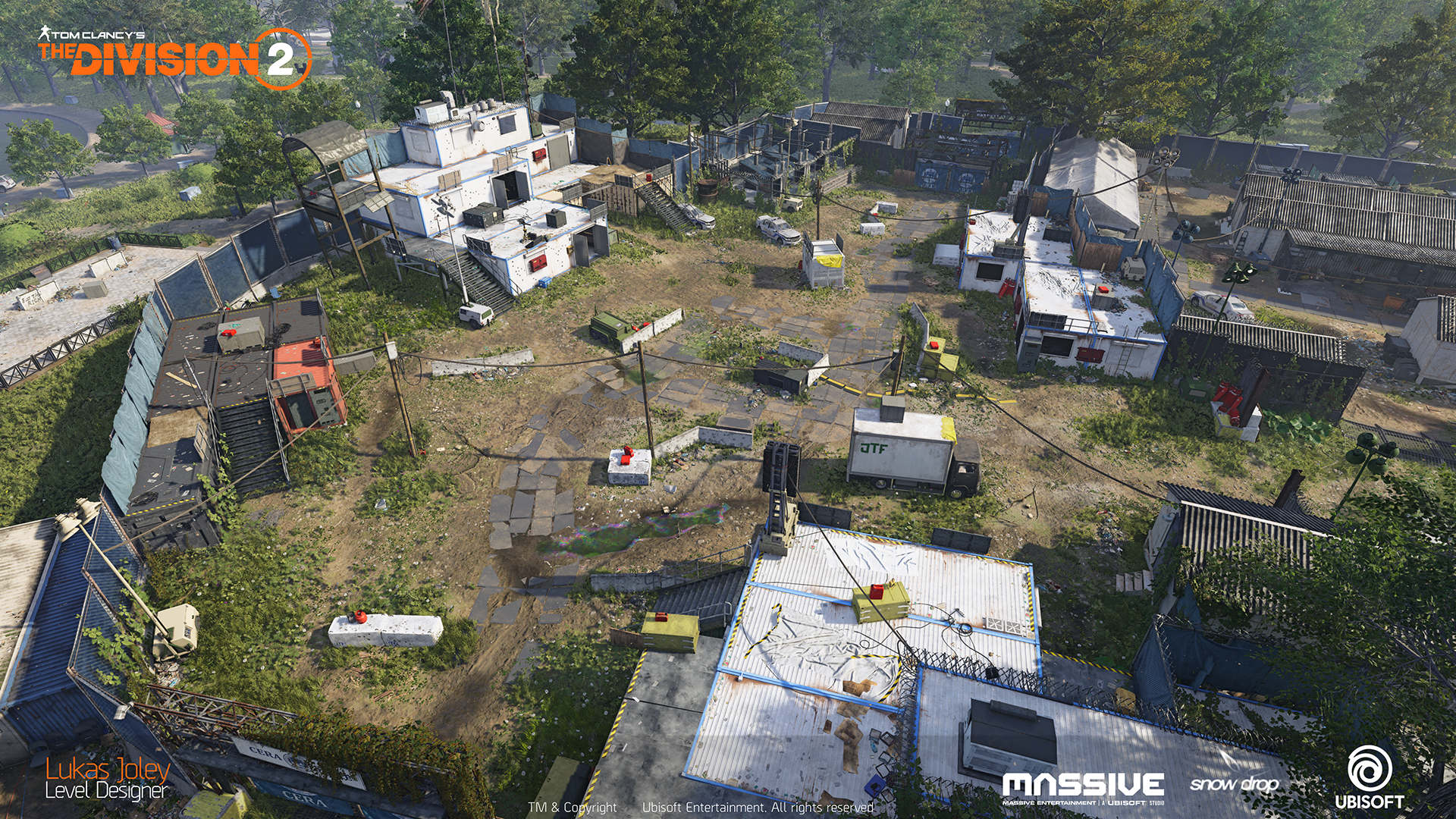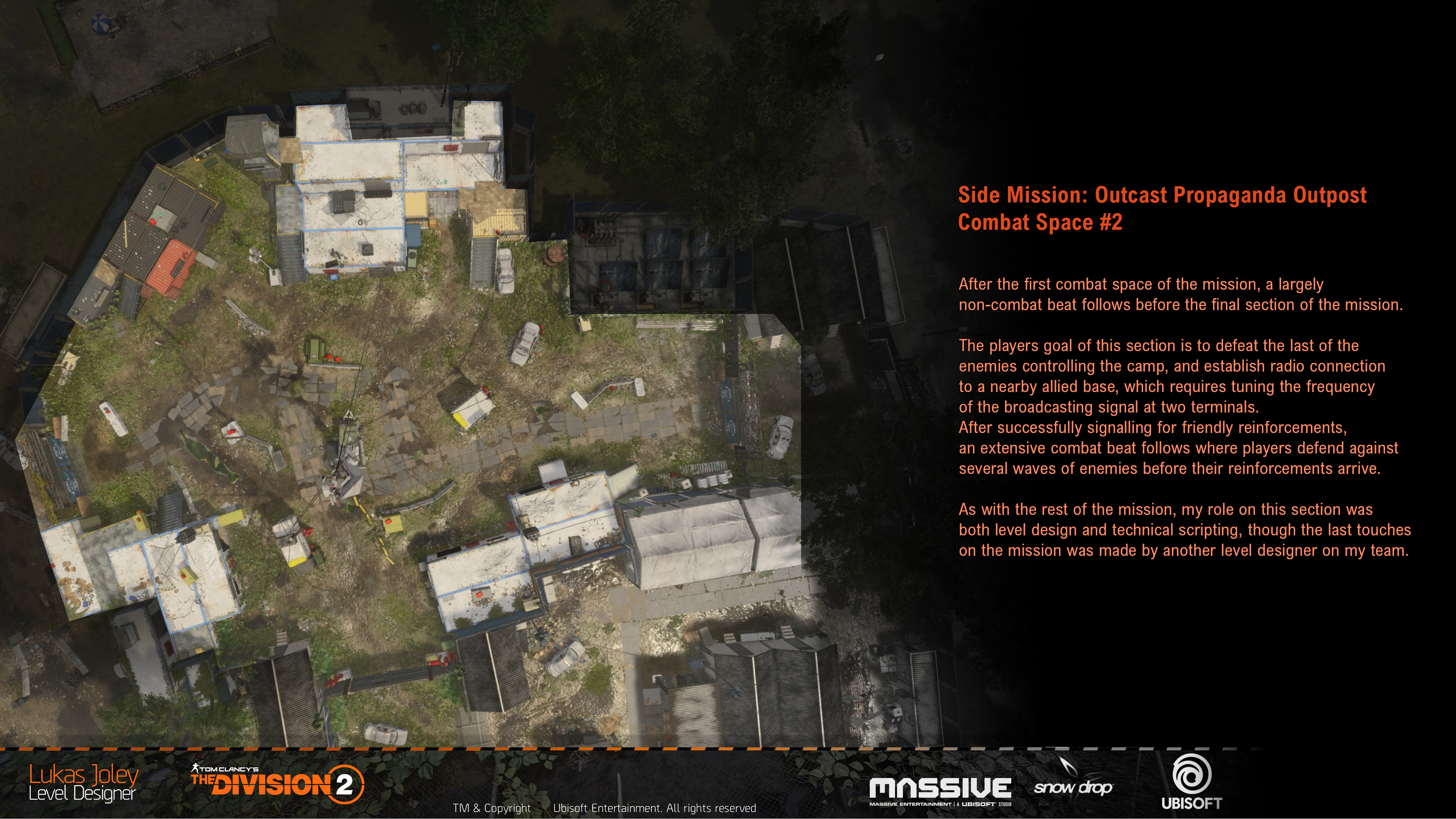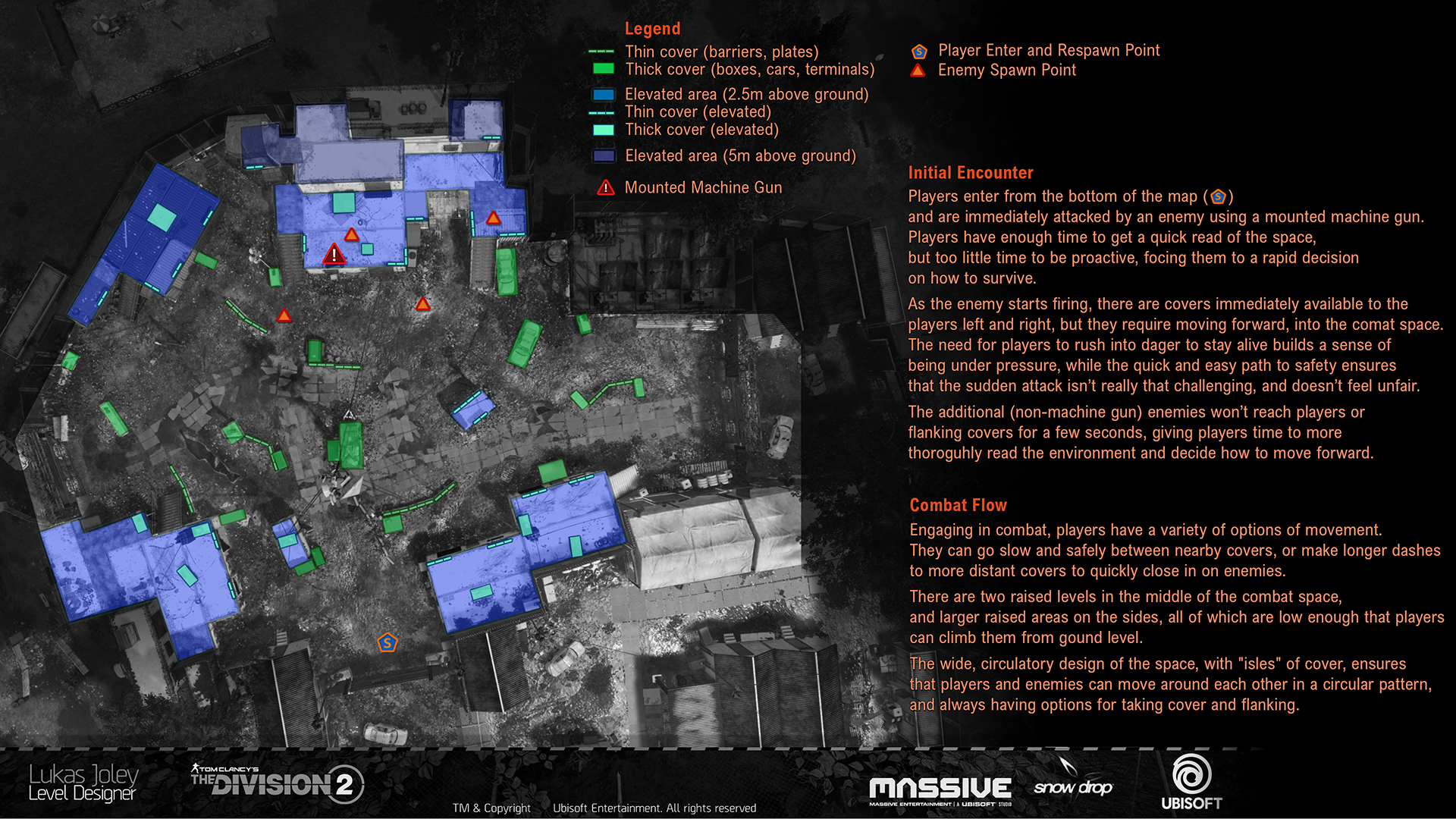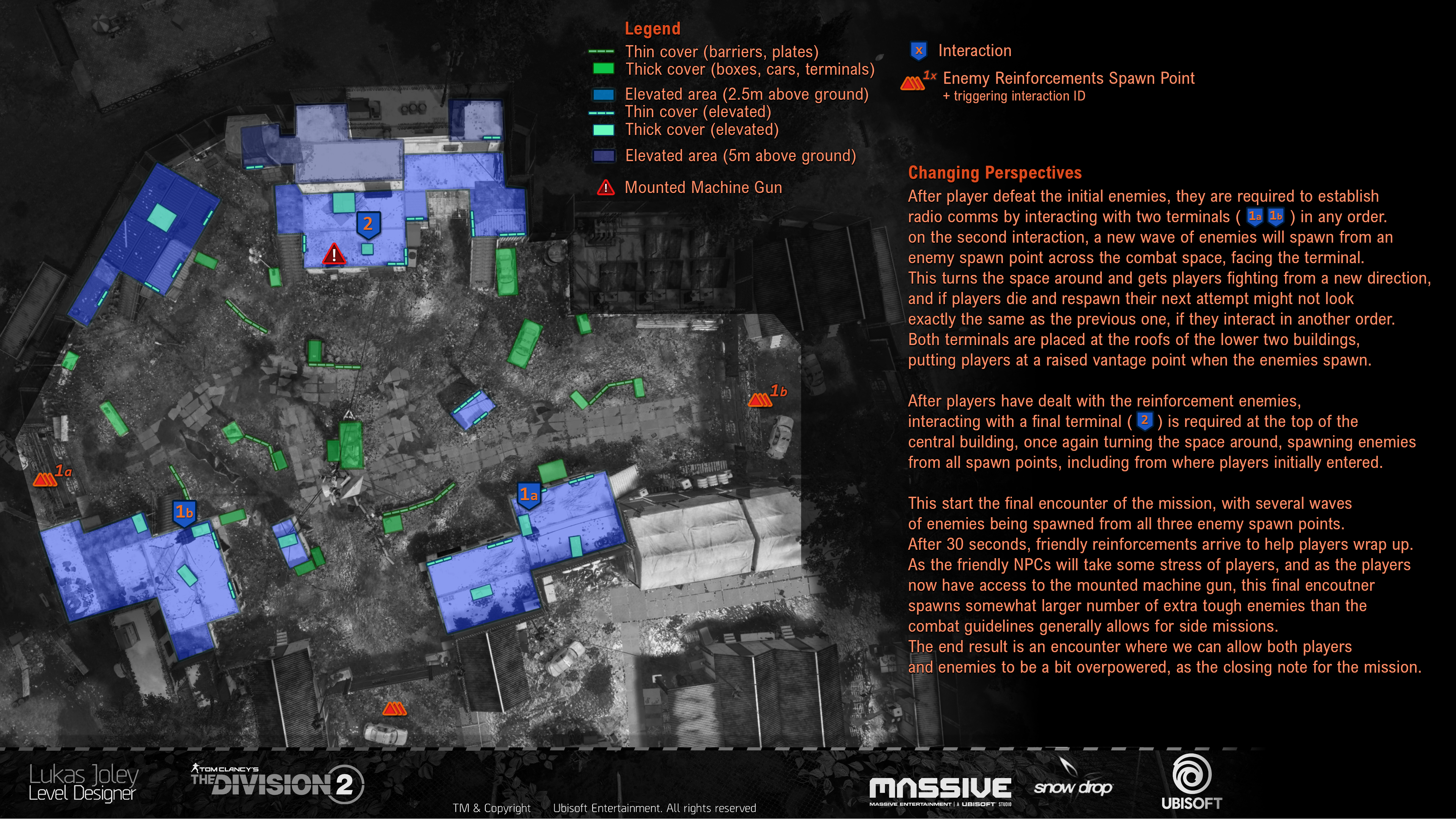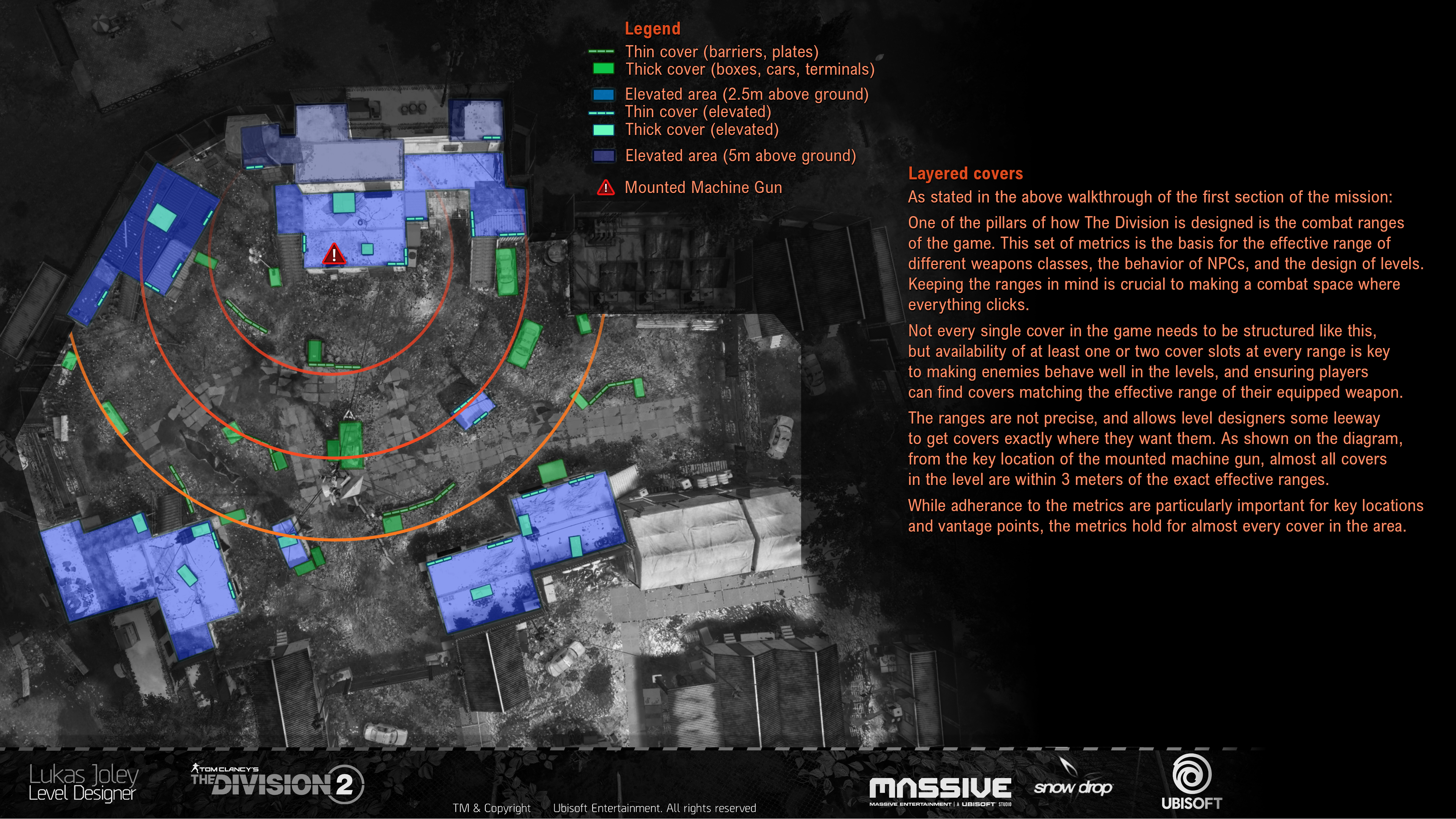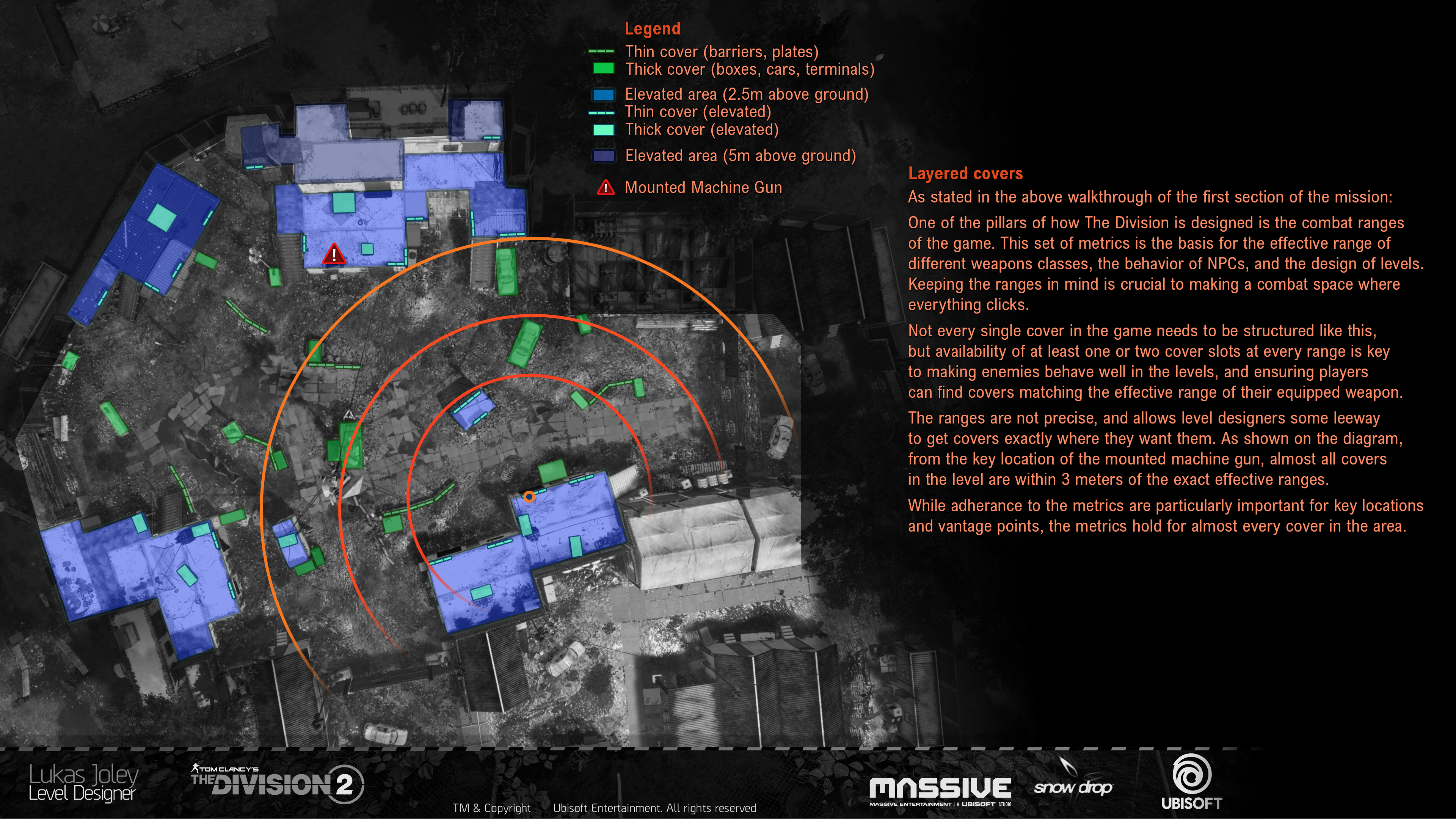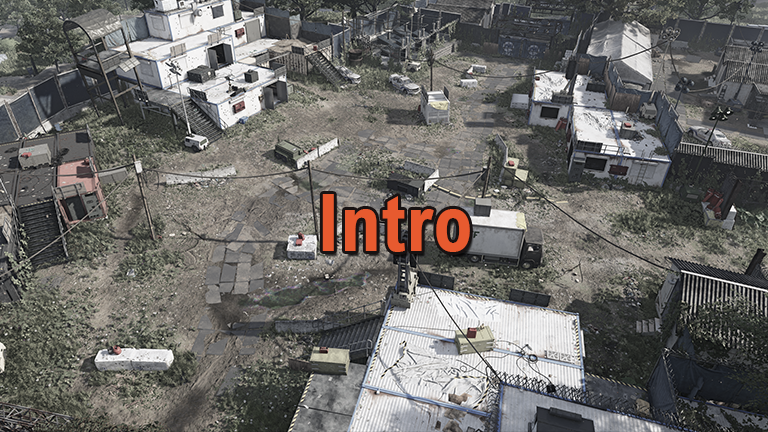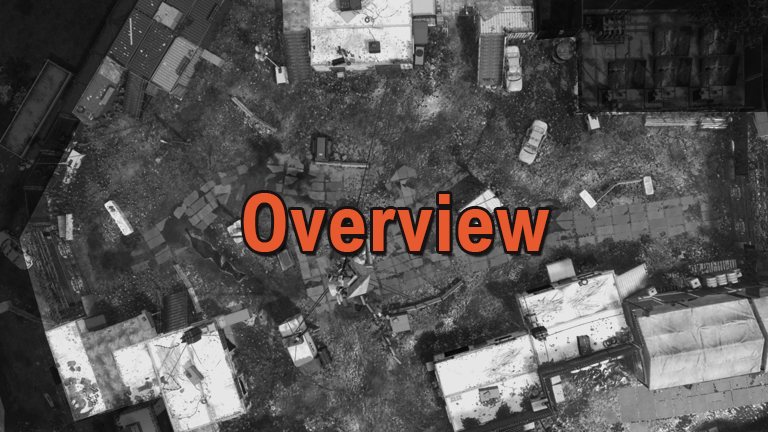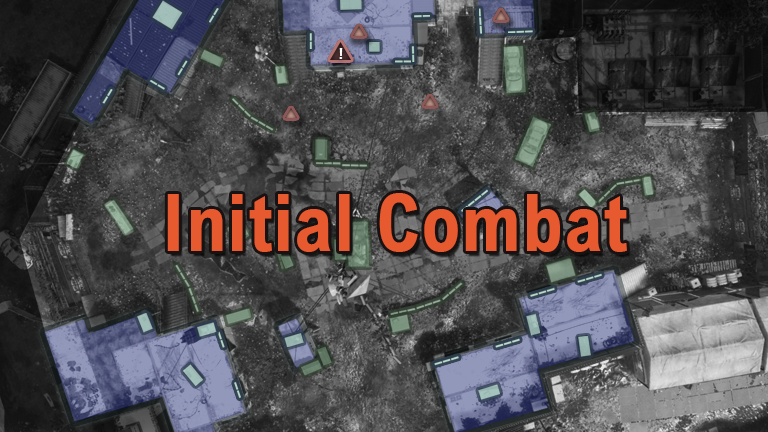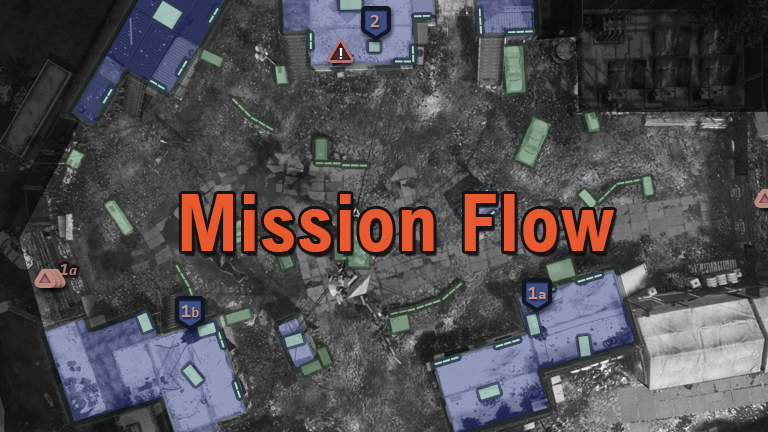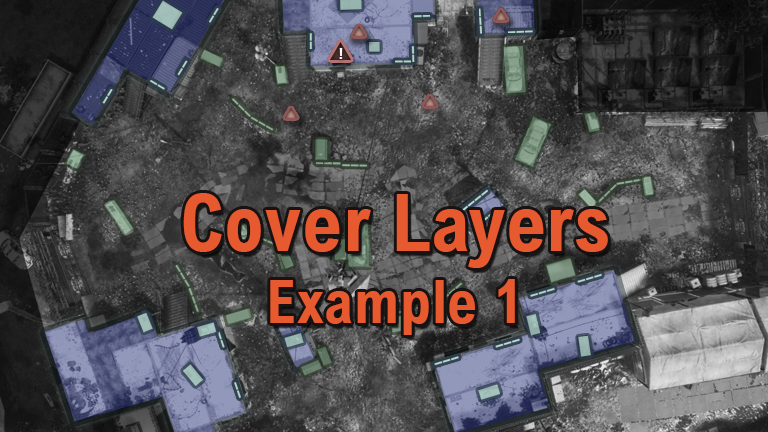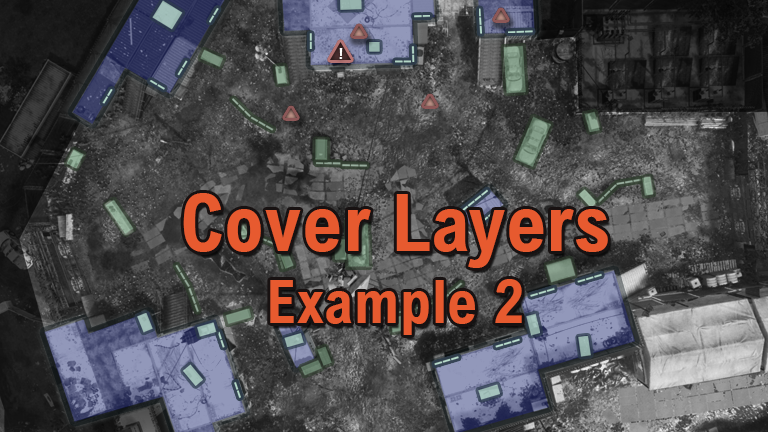Tom Clancy's The Division 2
Trailer | Massive Entertainment - A Ubisoft Studio | Released March 15 2019
As part of the Open World Level Design team, my main responsibilities on Tom Clancy's The Division 2 have included the design of various Control Points, Living World Activity sites, Side Missions, and distribution of Loot and Collectibles in the map. I've been heavily involved with shaping the new Living World System, which dramatically evolves gameplay in the Open World compared to the first The Division.
Responsibilies & Contributions
- Ownership of Constitution Hall Zone
I was the level designer for the Constitution Hall Zone, encountered at the midpoint of the game. With two additional Level Designers, I was responsible for planning the distribution of gameplay activities in the zone, and I was personally responsible for the layout design of all Control Points and Living World Activity sites in the Zone, and for distribution of Loot and Collectibles.
During the last phase of development, I was asked to support the Technical Level Design team, and handed over responsibility of the Zone to another Level Designer. - Design and Scripting of the "Outcast Propaganda Outpost" Side Mission
I had responsibility for the planning, mission design and level design of the Outcast Propaganda Outpost Side Mission in West Potomac Park. Together with level artists and narrative designers, I worked out the setting, visual themes and mission structure of the Side Mission and brought it from blockout to polish state.
As with the Constitution Hall Zone, I handed over responsibility of this Side Mission to another Level Designer during the last phase of development, to support the Technical Level Design team. - Planning Co-Ownership of West Potomac Park
Together with two other Level Designers I had responsibility for planning the distribution of gameplay locations in the eastern half of the West Potomac Park Zone, such as Control Points, Side Missions, and Living World Activity sites. - Design of Living World Activities
One of the largest changes in The Division 2 compared to its predecessor is the introduction of the Living World System, a complex system for dynamically distributing gameplay content on the map. It systemically populates areas, prepared by Level Designers, with various Living World Activities, providing dynamic gameplay opportunities of varying size. During the pre-production phase of development, I was part of the task force exploring how a system like this would work, both from a player point of view and from a technical and workflow perspective.
During production, I remained part of the LWS task force, where my responsibilities mainly covered the design and technical scripting of the certain Living World Activities. I was responsible for the design of the Target Practice, Rescue Operation and Propaganda Broadcast activities. - Technical Scripting of Living World Activities
During the late stages of the production phase of development, I was asked to assist the Technical Level Design team with technical scripting of Living World activities, and general support for certain features.
I took responsibility for scripting the Propaganda Broadcast, Rescue Operation, Territory Control and Elite Territory Control activities. - Technical Level Design Support
While Living World Activity scripting was my main focus supporting the Technical LD team, I also had responsibility for creating and maintaining several template assets that other Level Designers implemented on the map. This included the hidden Hunter fights, the various types of Collectibles, and the smaller script systems for spawning the Roaming Vendor, Named 52 and Snitch NPCs. - Studio Onboarding
During production, the Ubisoft Sofia studio joined the development team. As part of the onboarding process, I was asked to hold onsite workshops with the Level Design team at the Sofia studio to explain our workflows and design processes and guidelines, introduce the Snowdrop, and give feedback on their preliminary work.
Design breakdown: "Outcast Propaganda Outpost" Side Mission
This is a Side Mission from latter half of The Division 2. I worked on it as a Level Designer and Technical Scripter. It consists of one small combat section, one short non-combat section and finally one section with extensive combat. Below are presentations on the design patterns, intent and workflows on the two combat sections of the mission.
I was resonsible for this mission from early planning, blockout, and iteration until reaching a beta version. I was assisted by fellow Level Designers Felix Ekholm and Peter Ryde, during the early blockout and late polish phases respectively. The Level Artist responsible for this location was Adam Johansson.
Combat Space #1
▶ As this is the first beat of the mission, players can immediately find vantage points for scouting the area and plan their attack. While The Division is not a stealth game, we still aim to have a "planning phase" in when players are initiating the combat, and therefore often build vantage points at the edge of combat spaces. The two initial scouting locations are too far back for most weapons to engage in combat, suggesting players move further into the space before engaging enemies.
▶ The space is designed to have lots of leading lines drawing the players towards the back gate of the camp, leading to the next section of the mission. The thin covers pointing in the direction of the gate builds this visual, but they also communicate the two combat lanes of the space. The center of the space is where most players are likely to stay, and where NPCs will prefer to go. In this lane, covers are placed in chunks based on the effective range of medium range weapons. Along the outer wall, a more densely packed flanking lane allows short range players to get close to enemies, and attack across the narrow combat space.
▶ In a game set in an urban environment, you inevitably end up building much of the map in a quadratic fashion,to stay within the infrastructure of the world. Any chance to break up this "angularity" is welcome. As the camp is built on the National Mall, we decided from early on that we wanted to take the opportunity to build something less angular. The curved shape of the space makes it stand out in comparison to other Missions and Control Points, and was present already in the first iteration of the mission.
Combat Space #2
▶ As with the first combat section, we wanted to take the opportunity afforded to us by the location to build a highly "un-angular" combat space. The semi-circular, semi-triangular shape of the space lent itself well both to the logical idea of the space - being the heart of the camp - and the gameplay intention of making a space supporting a changing combat direction.
▶ In order to facilitate the changing directions of combat, most covers are placed in "isles", avoiding long lines of unbroken cover. This makes covers useful in several different fighting directions, but also decreases visual clutter in the scene. Maintaining readability of a combat space area is critical, and long lines of cover easily obscure each other. In a space where combat lines are meant to change, they easily end up an inconvenience for players. Thus, the open, uncluttered "tunnels" in the space are useful aesthetically, letting the space breathe, but also help players read and understand the environment.
▶ These open tunnels in the space also allows players to make quick darts between distant covers without needing to move around covers that get in their way.
▶ The intention for this section is to gradually change the framing, or mood, of the fighting. Upon entering the space, players are pinned down and underpowered. The next combat beat starts when players are at a vantage point, from where they can easily pick off the first wave of reinforcements. The final beat again gives players a vantage point, and this time a mounted weapon as well, giving them further advantages. In turn, the final waves of enemies are beefed up considerably, in terms of both numbers and strength, to still provide an escalation of challenge.
▶ The primary function of the space is, of course, to be fun. But it also needs to maintain at least some logical basis. The remains of a three-way vehicle path, from when the Camp was opertaional and has vehicles running through, can still be detected, though the months of fighting has shuffled props around.
The Living World System
While my primary responsibilities on The Division 2 was level design and scripting, a large part of my work related to the all new Living World System. The system is one of the largest changes in The Division 2 compared to its predecessor, driving the Open World experience with patrolling NPCs, Control Points and various gameplay acitivties. I was part of the small group developing the initial prototype for the system, and stayed part of the team as it grew to become one of the largest task forces on the project, consisting of game designers, gameplay and UI programmers, UI designers, level designers and technical level designers, and narrative designers.
The Next Step
After finishing development of the first The Division, there were two major areas where we wanted to improve the Open World experience; In the first game, all Open World acitivties were set at specific locations and once they were completed, these locations could no longer support other gameplay activities. Thus, the world always looked the same for every player and every playthrough, and once cleared it became empty of meaningful gameplay.
We wanted to make the world more dynamic and surprising, and we wanted to make the Open World stay relevant in the endgame. These goals became the foundations of the Living World System, and reaching them required resetting how we built the open world, both on a design level and technically.
A More Dynamic Open World
The core of the new Open World experience is the introduction of Control Points, fortified outposts controlled by the various enemy factions that players can attack and take over.
From these Control Points, enemies send convoys and patrols performing a variety of Living World Activities in specified location - unlike in the first game, the activities found at each location will vary, and the enemies can be encountered on the way to or from them. Once taken over, allied forces will start performing their own convoys, patrols and activities, sometimes even assisting players in their conquest of D.C.
During the story campaign, Control Points are permanently taken over by the player and their allies. The growing network of completed Control Points becomes a tangible, visual representation of the players progress through the game, and the proliferation of allied convoys and patrols shows their impact on the world. This was a major win in grounding the narrative of the game - taking back control of D.C. - in the gameplay progress.
Upon entering the endgame, the full flexibility of the Living World System is unlocked. Enemy factions gain the ability to take back Control Points, creating an infinitely replayable endgame activity where players can complete Living World Activities to "level up" a Control Point, turning it into a bigger challenge with a bigger reward when defeated.
Completing Living World Activities and clearing Control Points means that the endgame of The Division 2 is more than just grinding Main Missions - the Open World is not exhaused, but a central part of the endgame ecosystem.
Developing Our Workflows
Developing the LWS required rethinking the fundamentals of how we created the game, both as level designers and from a technical perspective.
For the level designers, we developed new proprietary tools for virtualizing the props and markup needed for the mission logic scripts to function, and new workflows for creating combat layouts that worked with multiple angles of approach and different logic flows.
For Technical Level Designers, new script systems were developed that could communicate with the gameworld via virtual references to props and game entities, a vital change to the now "location agnostic" gameplay logic.
The system also impacted how we planned the world from a macro perspective. The network of paths between different Control Points, and the locations they send their troops to, now become potential combat locations, and traversal spaces that players will revisist time and time again, requiring a new perspective on their design.
All in all, the development and use of the system impacted every aspect of the Open World and, in our opinion, left it greatly improved.
